Maybe a decade ago -- while cozied up to a small riverside campfire -- I first heard the idea of connecting the Salmon River with the Selway. Trundling a boat from the former to the latter sounded long and hard, but the Selway held such mythical status that it was -- within this group at least -- clearly understood to be a worthy endeavor. Truth be told it was the first I'd heard of the Selway, so new was I to running rivers. While many in that community consider floating the Middle Fork and then 'turning the corner' to continue down the Main as the ne plus ultra of the genre, for a certain subset of humans that just wasn't ever going to be enough.

Last spring I had hoped to traverse the entire South Route of the Iditarod Trail by fatbike with Jeny. Our mid-winter move to Idaho forced us to back-burner the idea, and then COVID kicked that can yet further down the road. As we slid down into winter it became clear that no Alaskan bush communities were going to be ready to welcome outsiders, so the idea was shelved indefinitely. I'm not sure if Jeff knew any of this when he pitched the idea for this traverse, but his timing was excellent: Jeny and I wanted a big trip on the calendar for late winter/early spring, and one that took in a big chunk of our new backyard was super compelling.
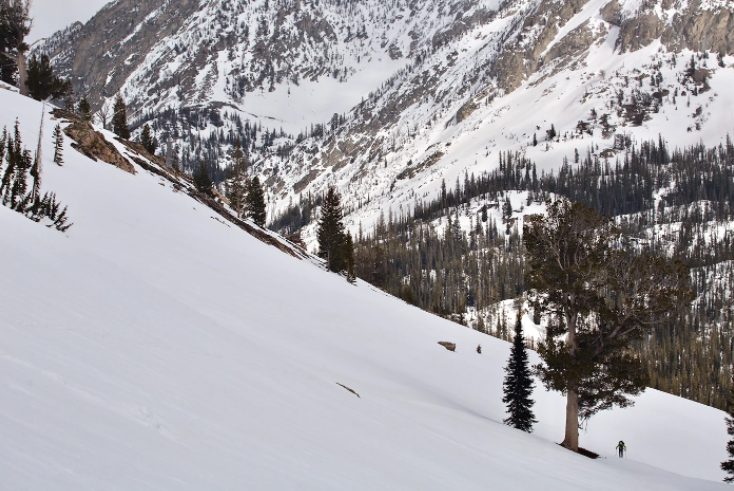
What Jeff proposed was a 300+ mile route, starting with a ~60 mile ski tour through the Sawtooths that ended at the highest likely point of navigability for Marsh Creek. We'd then inflate boats (with skis stashed inside) and float ~130 miles of Marsh, Middle Fork, and the Main Salmon before deflating boats and starting the big portage: something like 45 miles to get up, over, and down to the Selway. A few thousand feet above the Main we hoped to hit snowline, not just to get skis and boots off of backs and onto feet, but also to fill in some of the matchsticked burned zones. Once at the Selway we'd have an ~80 mile float out.
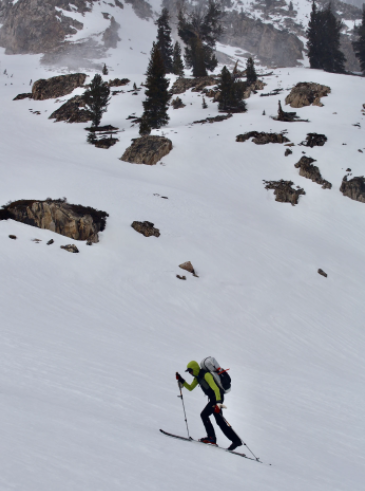
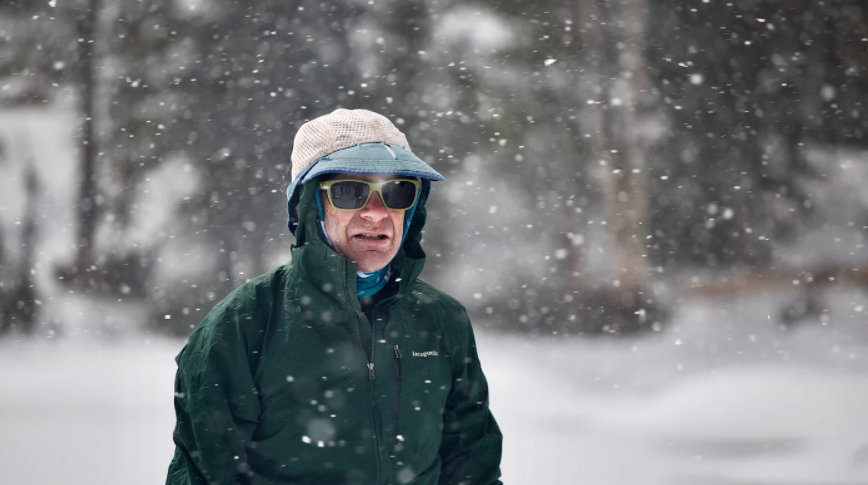
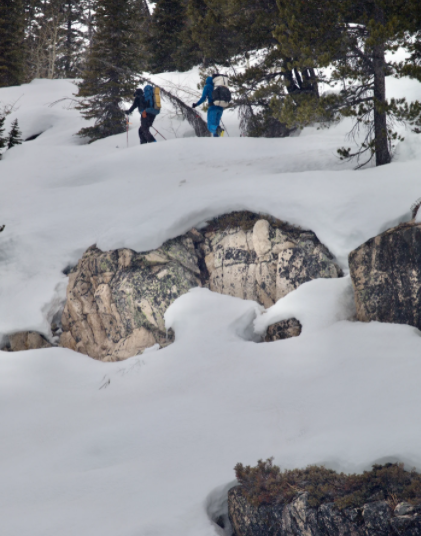
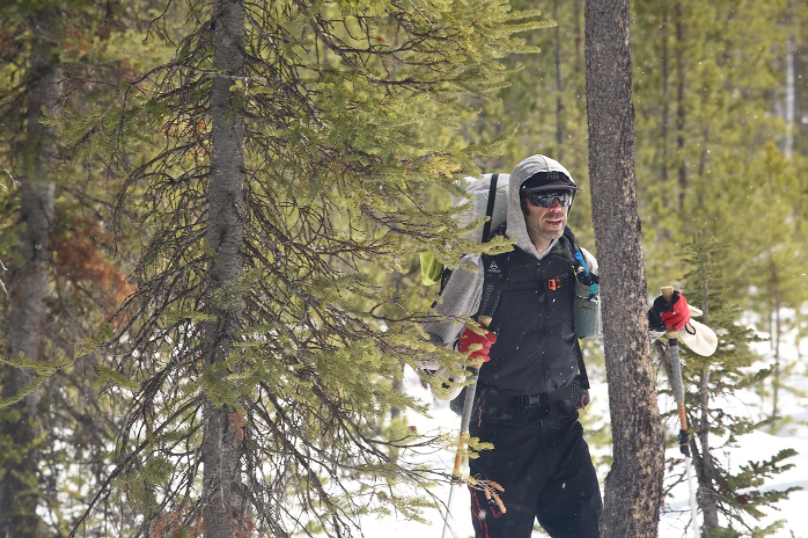

Thus did a group of us descend on the southern Sawtooths early in April. We heaved gear wholesale out of vehicles and onto the ground, shuffled it onto our feet and into packs, then slowly inched our way into the range. Jeny had been called by work a week earlier and couldn't demur, which left us with a sausage party including Jeff, Brian, Tom, Jesse, Allen, Bryan, and myself.
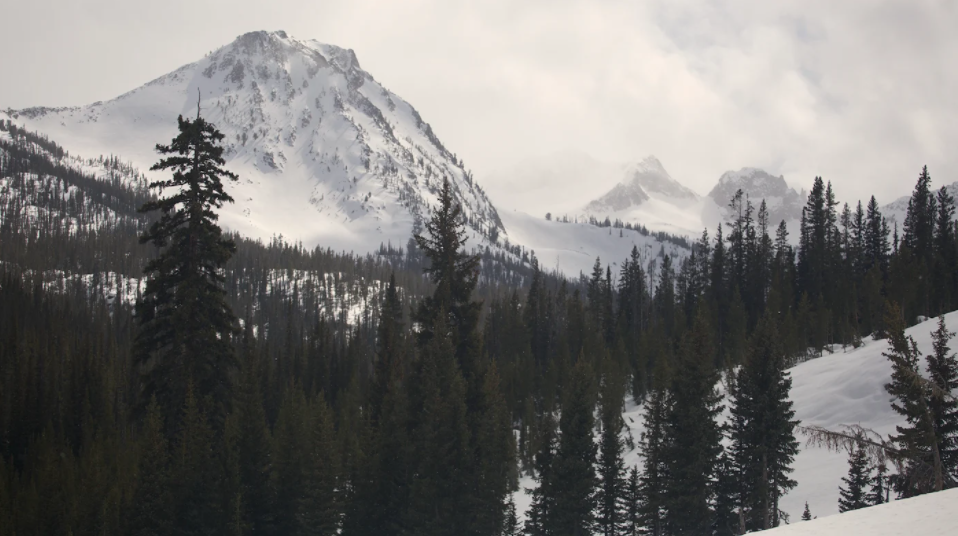
Ask five weather forecasters what to expect this time of year in the 'tooths and you'll get as many heavily prevaricated responses. Spring temps are likely but winter has not yet loosed her grip. We straddled the line between the two daily, even hourly, with flurries giving way to blistering sun, followed by brief ground blizzards, punctuated by crisp, clear, single digit overnights.



Our general south to north trajectory meant that the climbs were reliably frozen stiff in the early mornings, and might just soften some by afternoon. Ascending conditions ranged from bulletproof avy debris to spreadable, edgeable cream cheese.
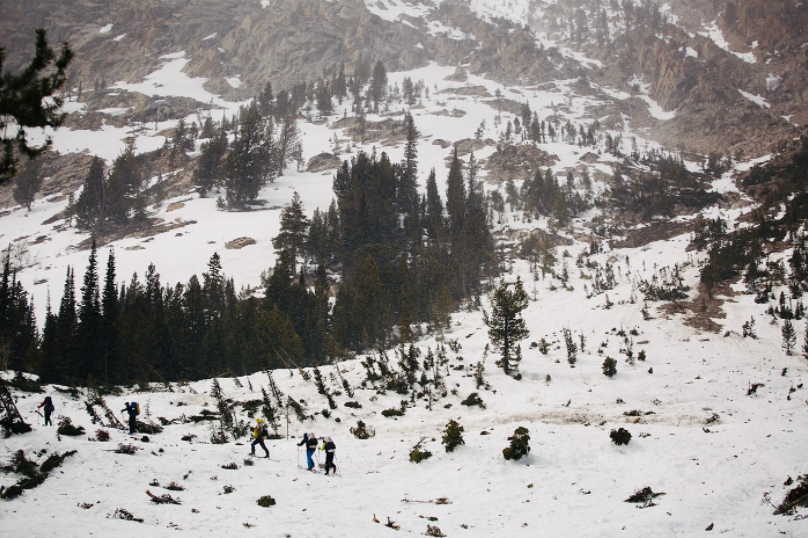
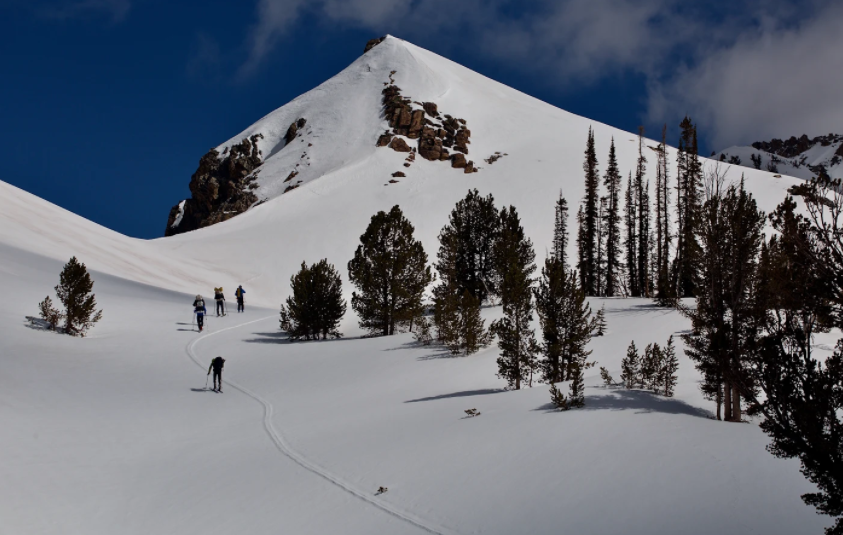
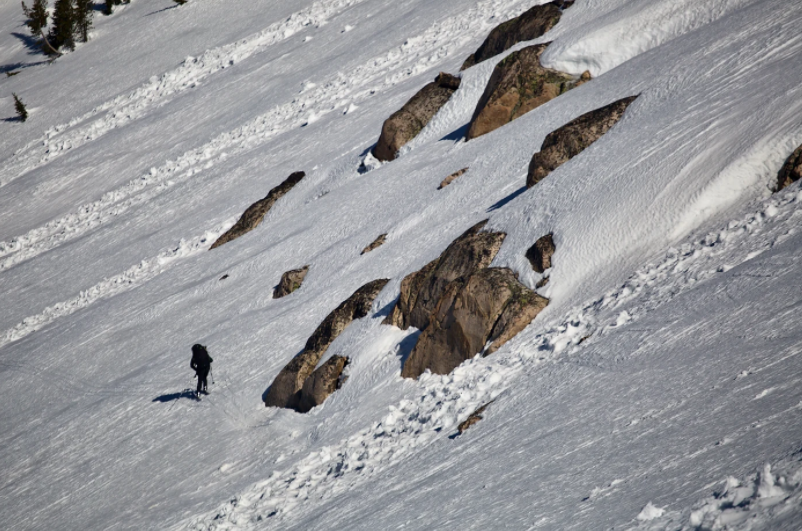
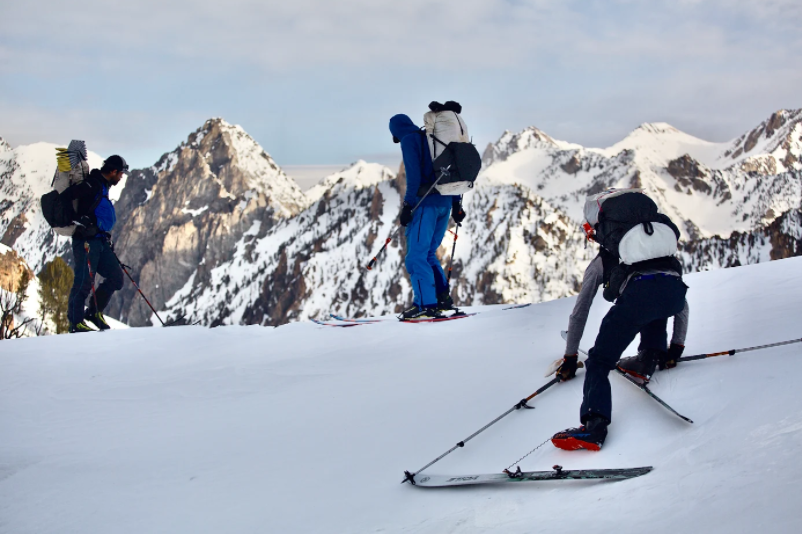
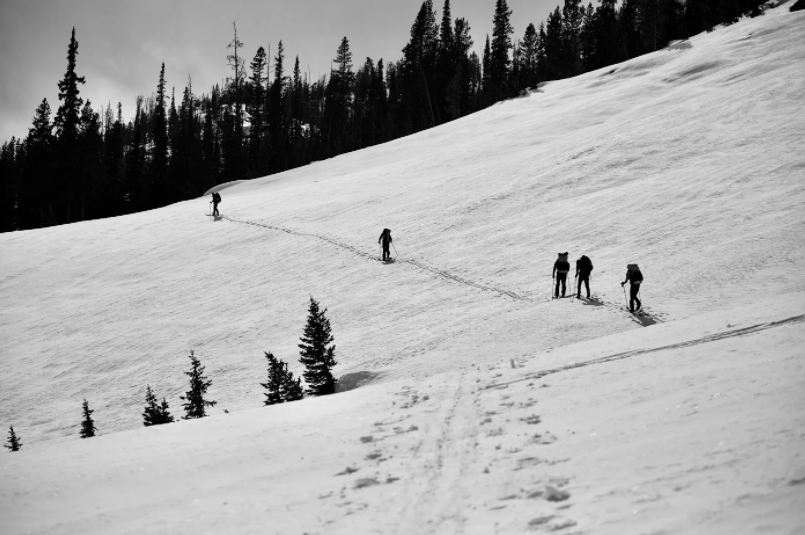
My favorite moments of this leg of our route were when crossing the many lakes -- for I could 'check out' on worrying about fine foot placement or edge control and just shuffle along while savoring the unfolding scene.
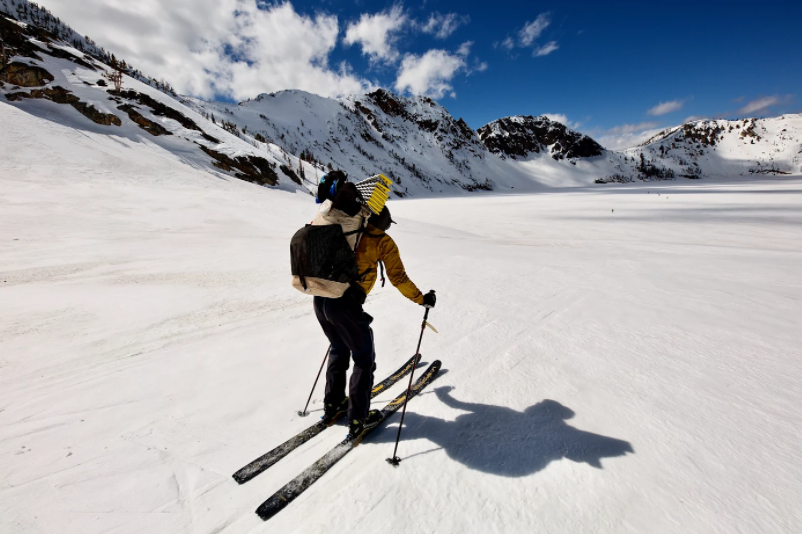
I think a large part of this is that I grew up on lakes -- canoeing, swimming, ice skating -- and as such have been comfortable there from my earliest days. Put me on a steep slope with a jagged, crenelated ridgeline above and I'm tense. Anxious bordering on stressed. You can lure me out of the flatlands but you'll never beat the flatlands out of me.
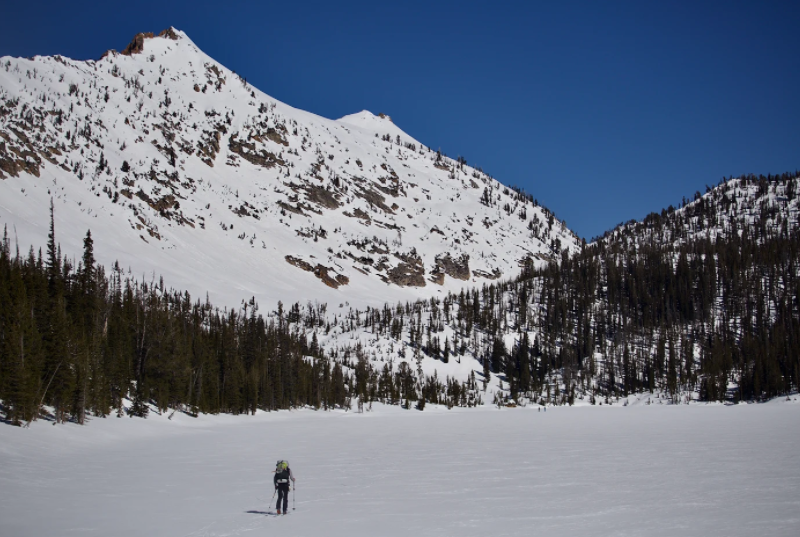
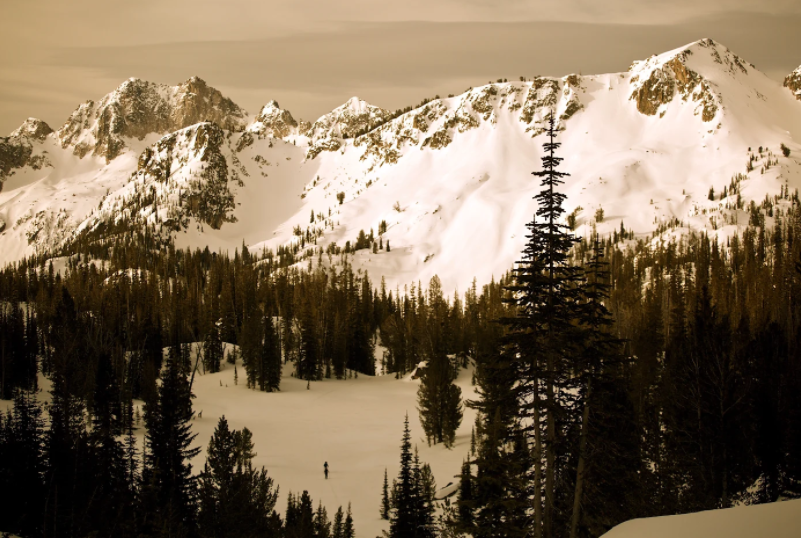
Of our many skin to ski or ski to skin transitions a very few stand out. Most were all business: rip and stash skins and resume movement to get out of the wind. Or wipe on skins while trying to keep the group in sight. My transitions were practiced and efficient but when moving I simply couldn't keep up with this group. I forewent refueling for big chunks of each day because in so doing I could buy brief bits of time to snap pics before the team got antsy waiting for me. The transition pictured below was one of the most memorable: stunning scenery and a rare pass devoid of wind meant that we lingered for precious moments before clicking in and gliding silently on.
.png)
Most of our descents had highly variable snow conditions. Northern aspects don't get much sun this time of year, thus were they consistently inconsistent and unpredictably wind affected. Allen, Bryan, Jesse and Tom arced powerful, confident lines through these tricky layers, never so much as hinting that the conditions were anything other than delightful.
.png)
.png)
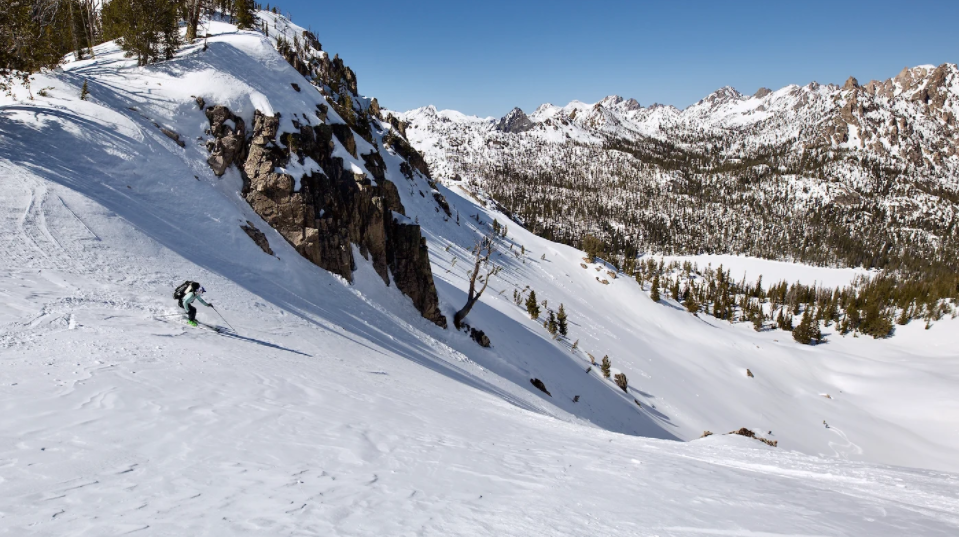
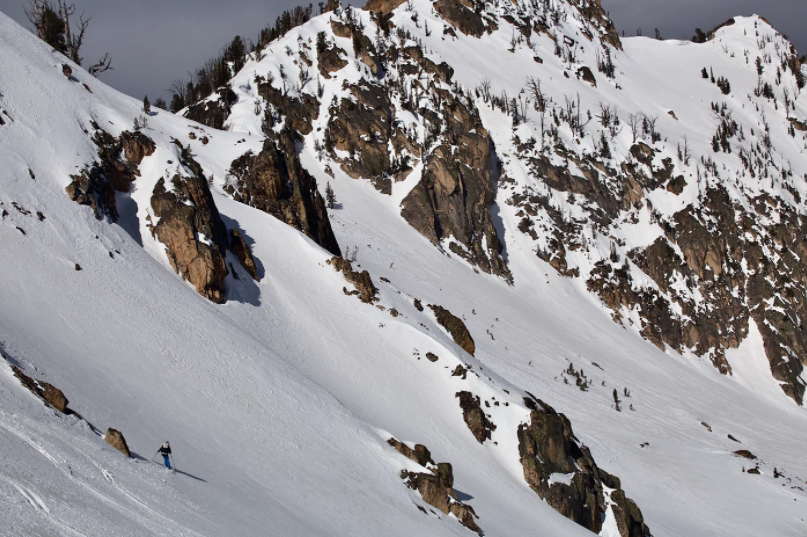
Jeff, Brian, and myself were more tentative -- survival skiing, ski-cutting, sideslipping, and kick-turning our way down to more consistent snow, or gentler slopes. Or both.
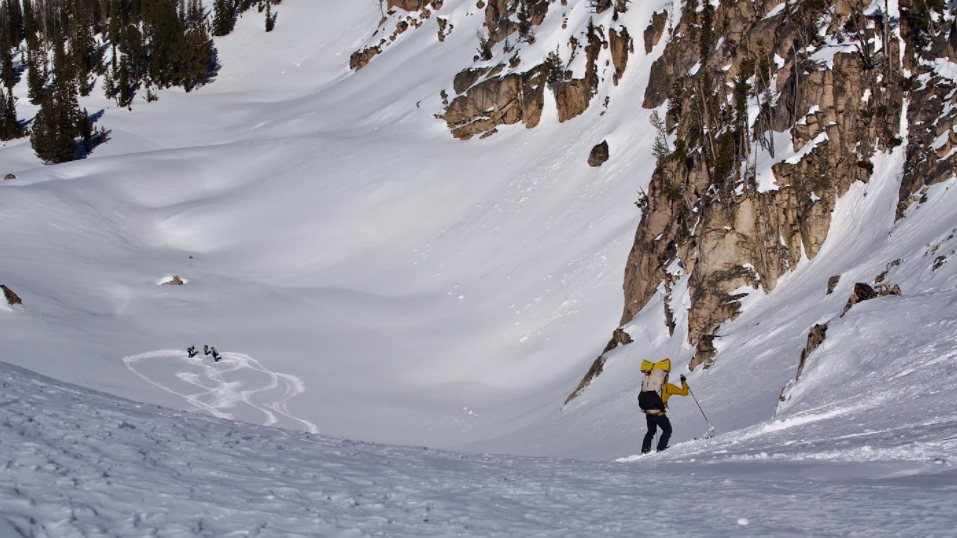
Our packs were close in bulk and weight. I never could understand how the others could make such consistent turns despite the substantial added mass on our backs. That they are just plain better skiers -- with heaps more time in the backcountry -- is the obvious answer.
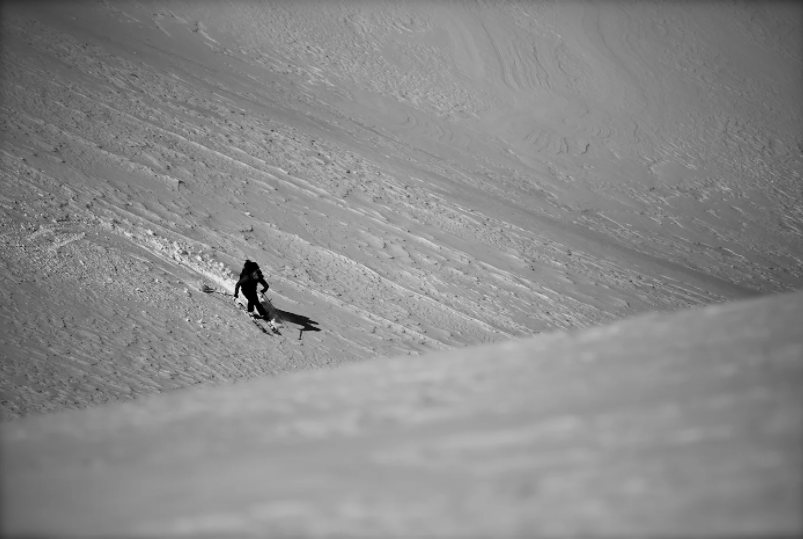
Our five days in the Sawtooths took on a predictable, almost meditative rhythm: We got up early, but not too early. We breakfasted and caffeinated while breaking camp, for it was too sharp to comfortably lounge at that hour. We moved consistently through the bulk of each day, always stopping early enough to set up camp in direct sun. The last man standing -- usually me, photogeeking stars -- would be down for the count by ten. And then we'd do it again.
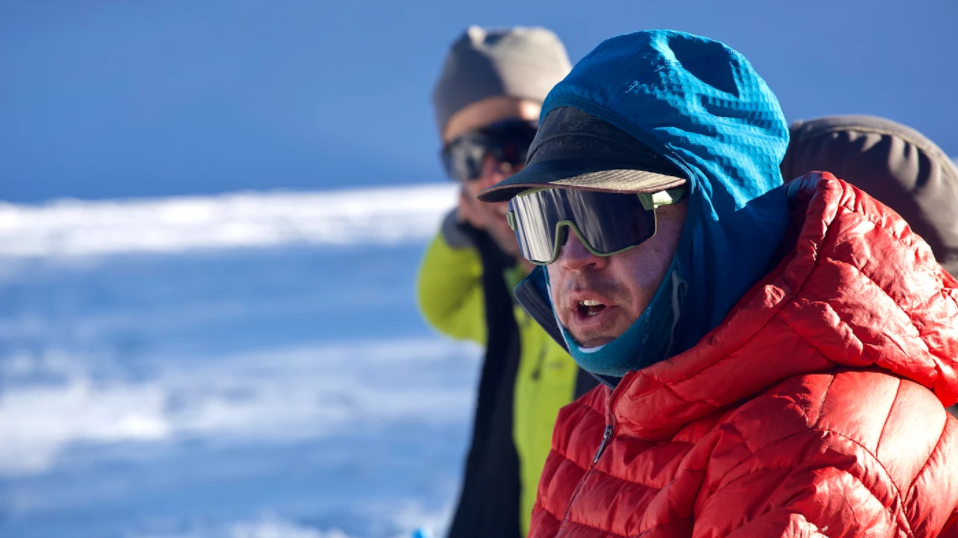
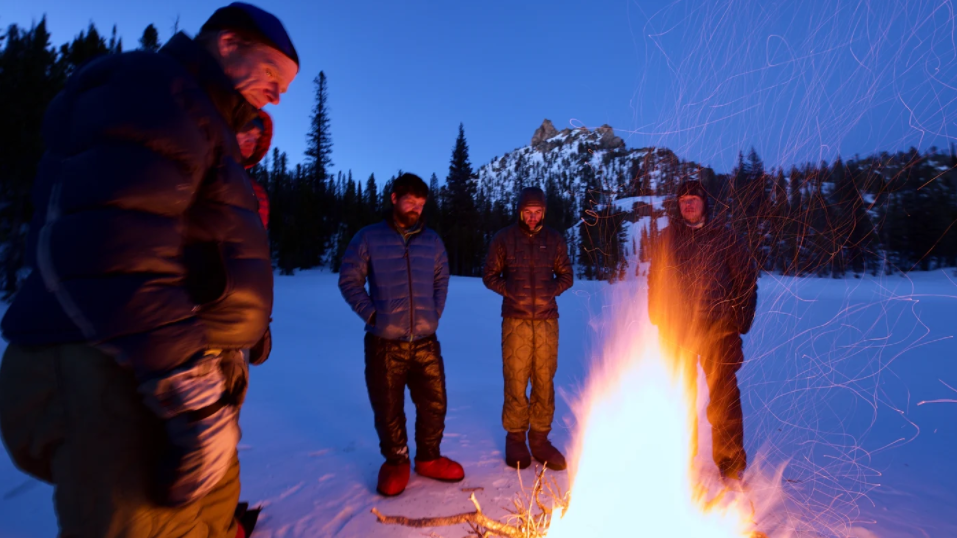
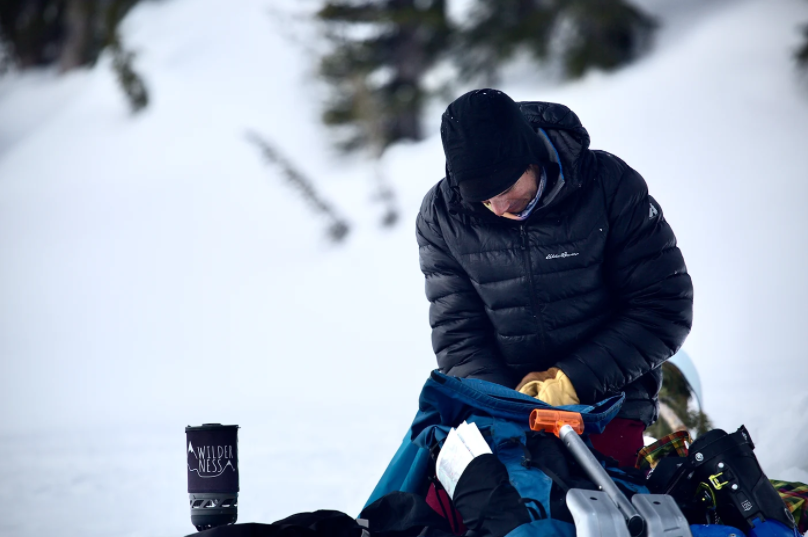

.jpeg)
One of the most memorable moments of this segment was when we were overflown by a flock of snow geese while high in the alpine. We heard them before seeing them, and then remained mesmerized watching the forerunners slide back for rest as laggards snapped-to to do some work. Said Bryan: "I was struck by the natural flowing shape. It seemed like one enormous, fluid organism instead of a ton of geese. The whitish silver of their bodies against the bright blue sky was really cool, too."
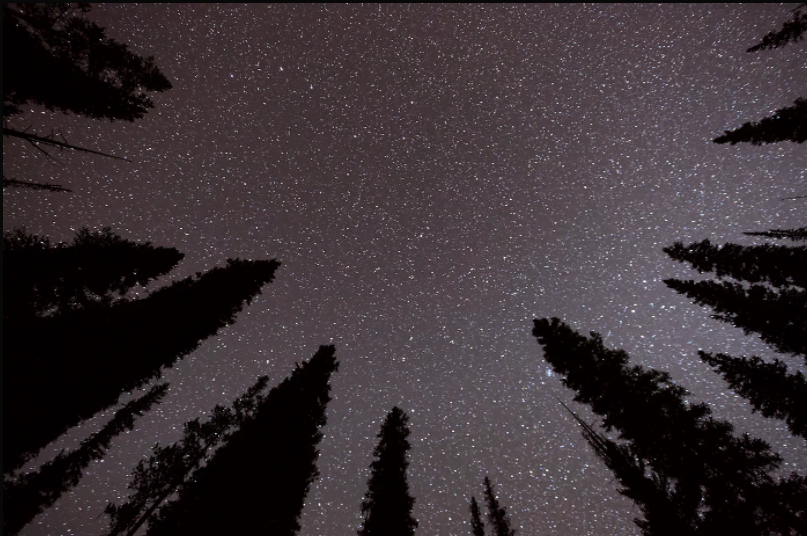
We shared snacks and stoves, melting snow when necessary but scooping from creeks when possible. Most of our lunch breaks happened down low rather than up high, a fact that I attribute more to a lack of wind in the thickly treed hollows than anything else. A desire to move fast and light kept our food options relatively uninspired -- especially compared to what was to come. Although Brian noted that "Watching Jeff Jetboil sausages in his tea water was pretty memorable...".
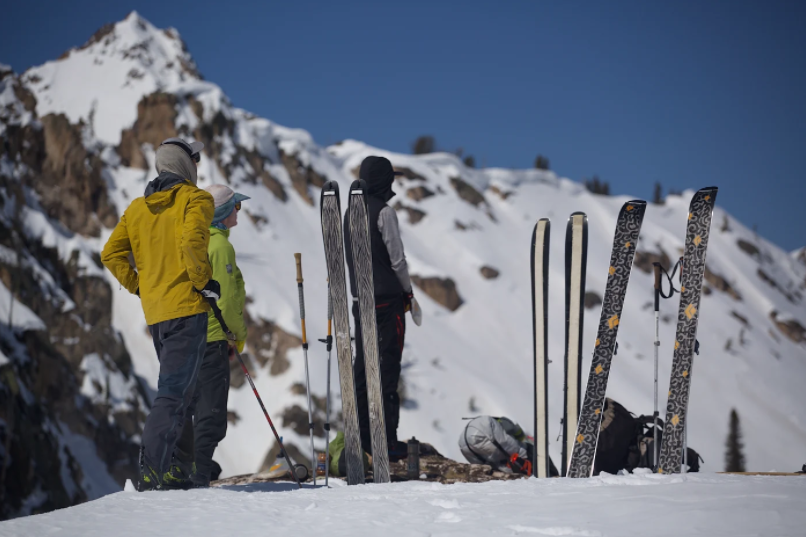
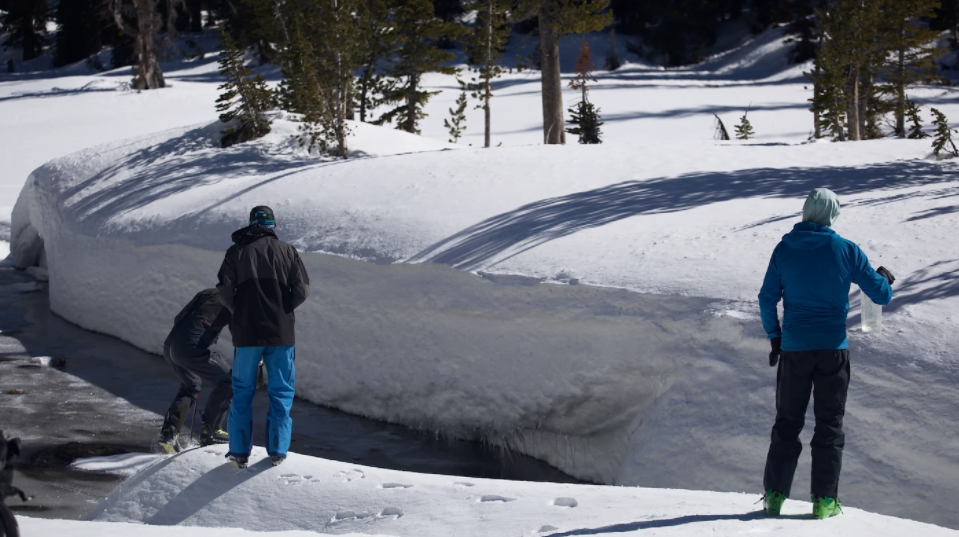

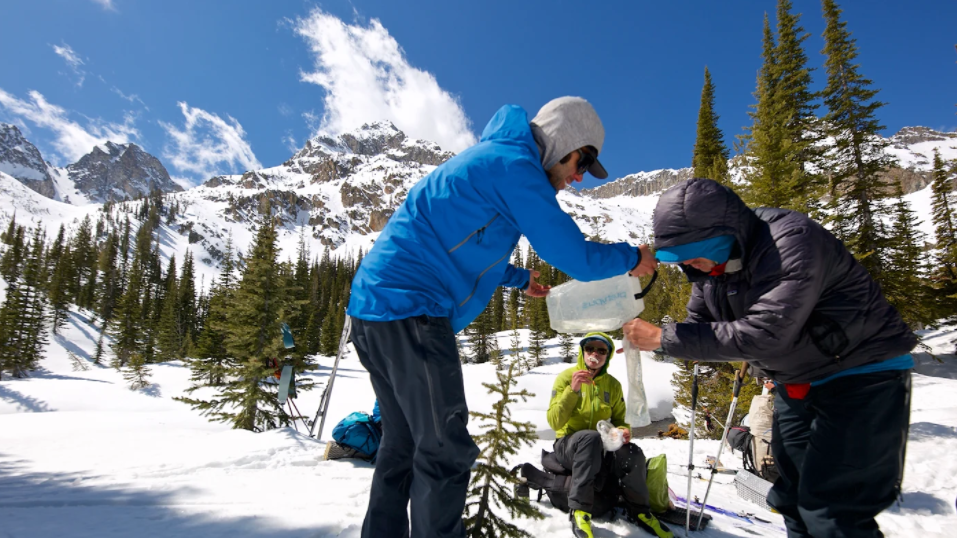
If I were forced to pull a single moment from this segment to cling to for eternity, forgoing all others, it would have to be the one pictured below. Big, complex terrain, teeny tiny us, and miles to go before we sleep.

Were I allowed to elaborate on that moment I'd stretch it to include the middle chunk of that day: A complex descent 'neath the shadow of Baron Peak, traversing beneath a ring of high points bathed in brilliant mid-day light, a sun-soaked lunch stop, silky creamed corn on which to ascend an improbably direct route to the shoulder of Mount Regan, and then nuclear tailwinds blowing us through a pass and out across Sawtooth Lake.
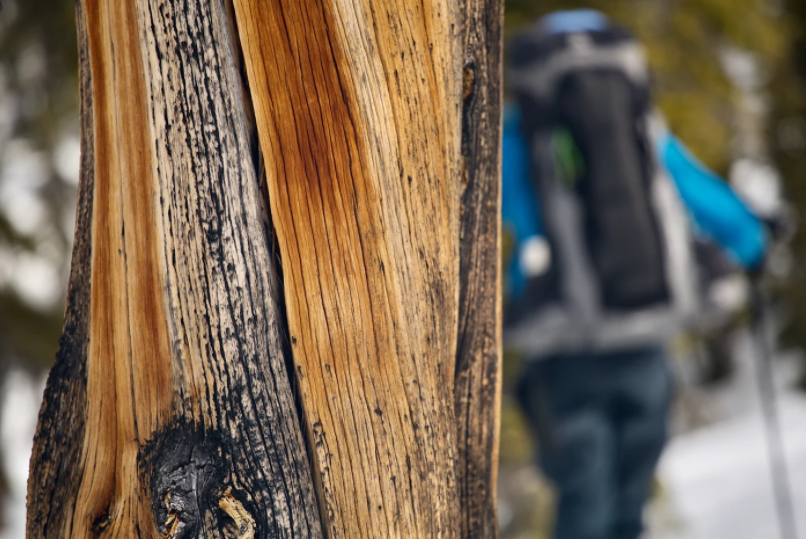


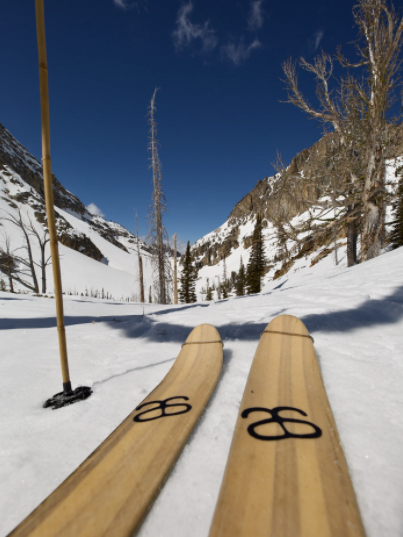
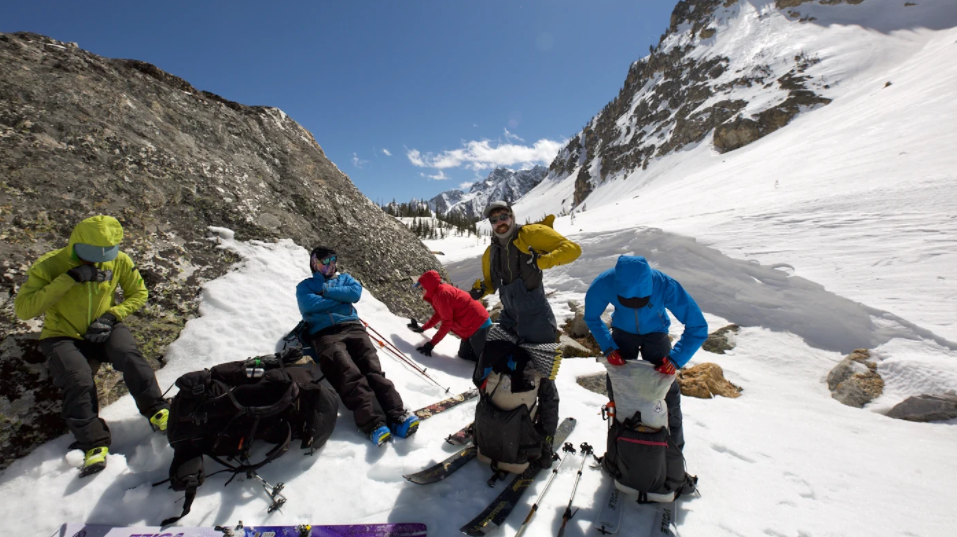
Lest there exist any doubt about the poignance of that extended moment, all I need to do is refer to the shot below: A pile of big toothy grins bared against the face of the aforementioned gale, utterly content in that moment and wishing only to be right there embracing it.
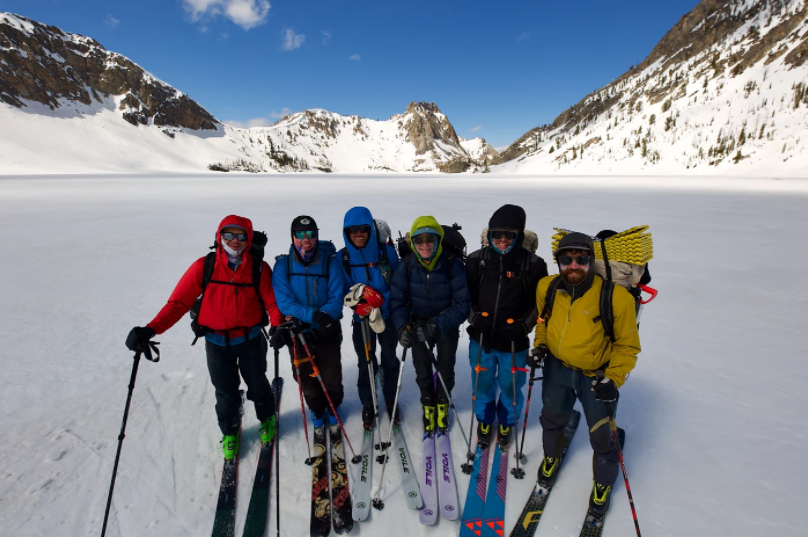
Spirits remained high as we descended from a literal and emotional high point, short climbs and long gliding descents stepping us down out of the range as we started to think about...
...paddling.
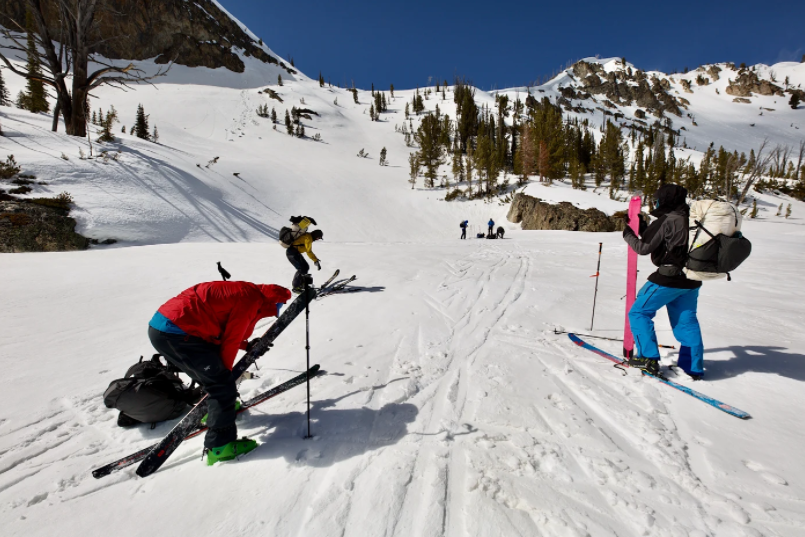
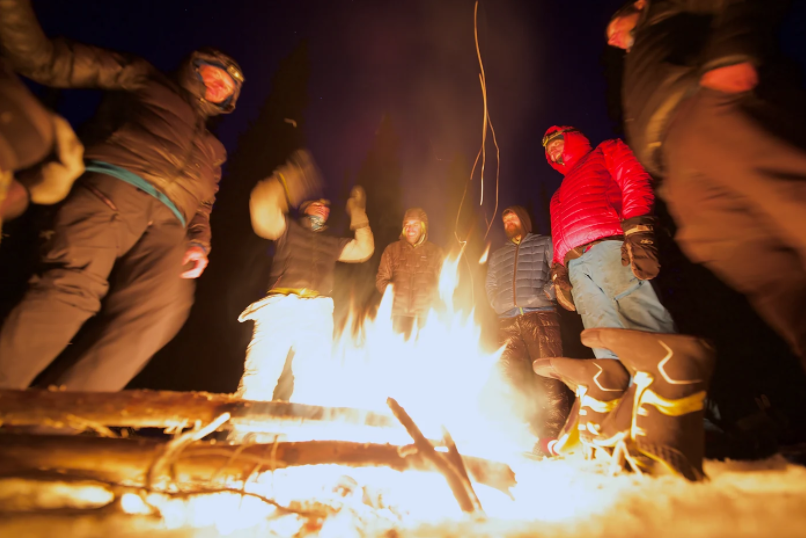
And then, change: The Salmon River Mountains coming into focus.
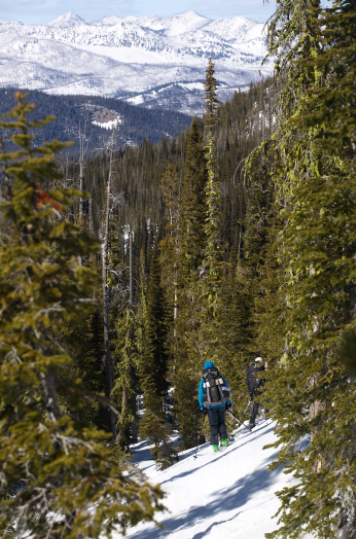
We left the Sawtooths with a few miles of early morning kicking, gliding and skating to Marsh Creek. I stopped twice to identify odd purring noises emanating from my skis, which turned out to be the adjacent floodplain filthy with Sandhill Cranes.
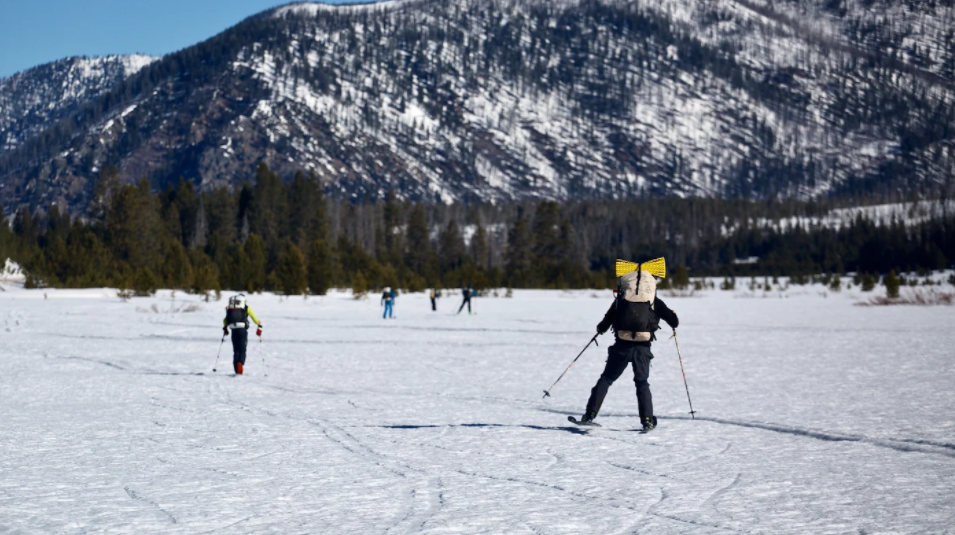
Where our route crossed Hwy 21 we'd left a vehicle with our sole cache for the trip. There we stuffed skis and 10 days of food into our boats while cramming fresh food into our pieholes.
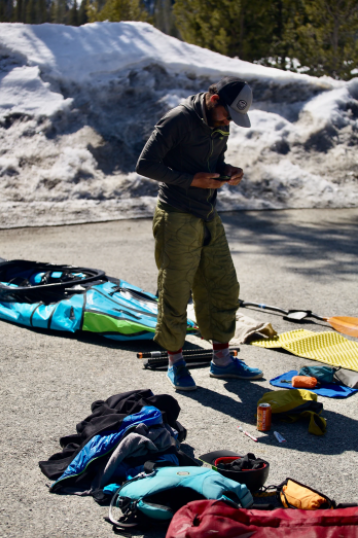
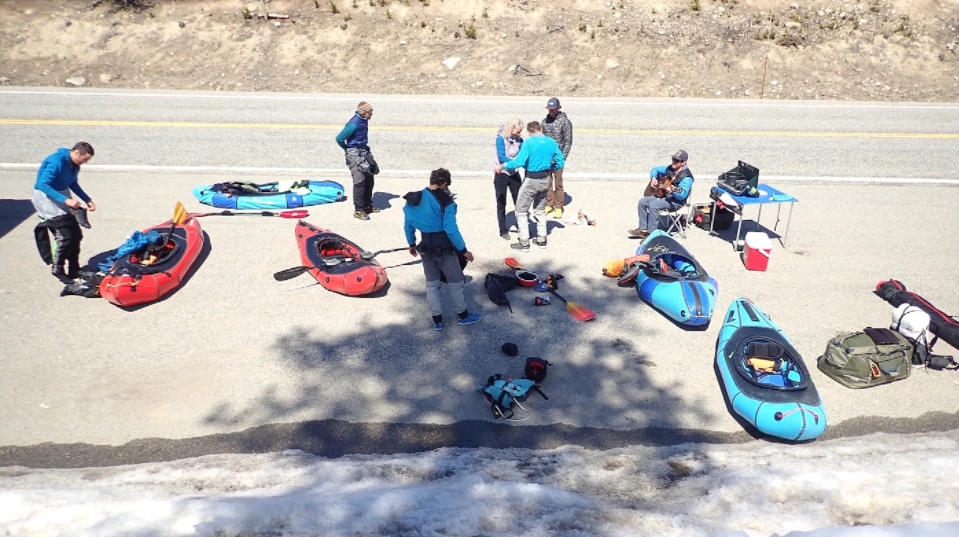
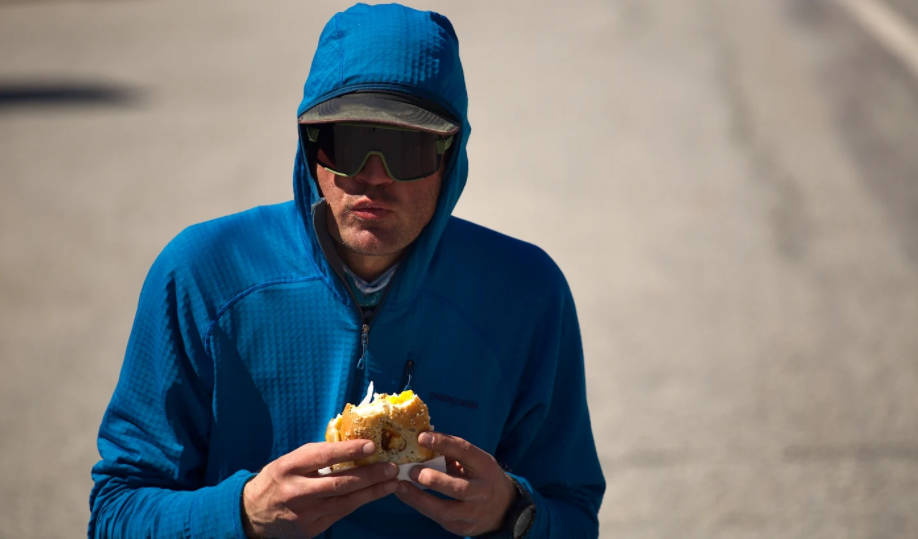
We were enlivened by the company of Jeny (and the food she brought) as well as the strumming of Allen (and the food he made). We were sad to lose two of our team here: Brian to a bum shoulder and Allen to a rigid work schedule.
A few last looks around, with errant layers and calories retrieved and stuffed into already bloated boats, then we dragged our inflated crafts down a sledneck track, said our goodbyes, and launched into a thin but floatable Marsh Creek.
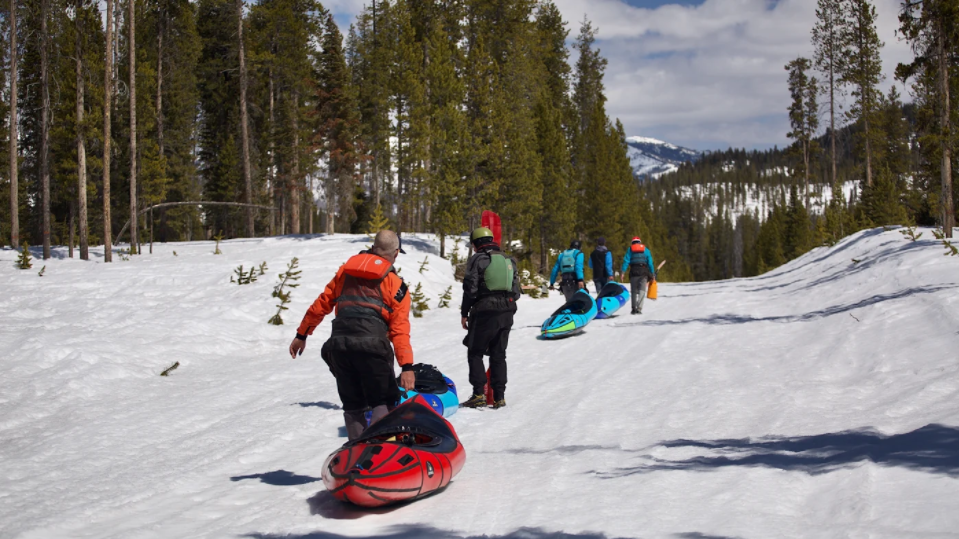
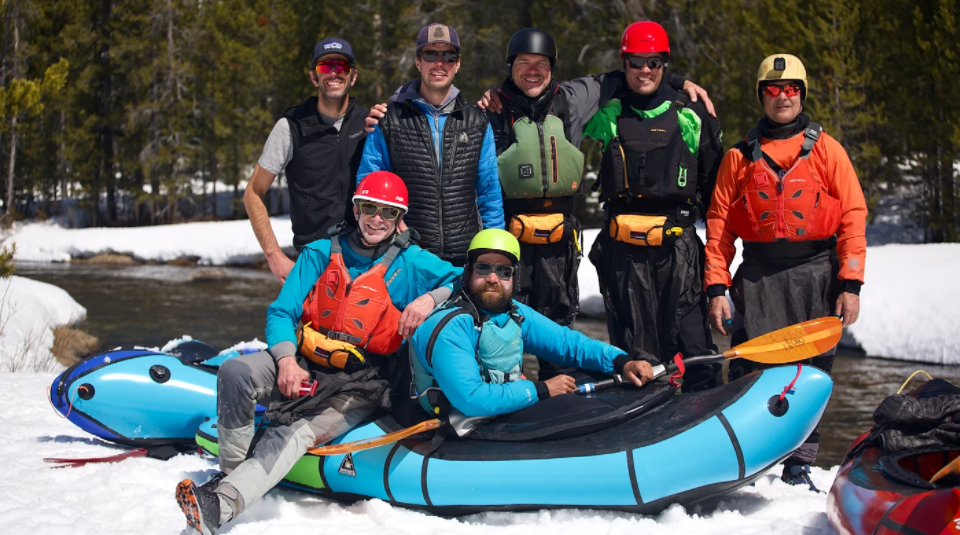
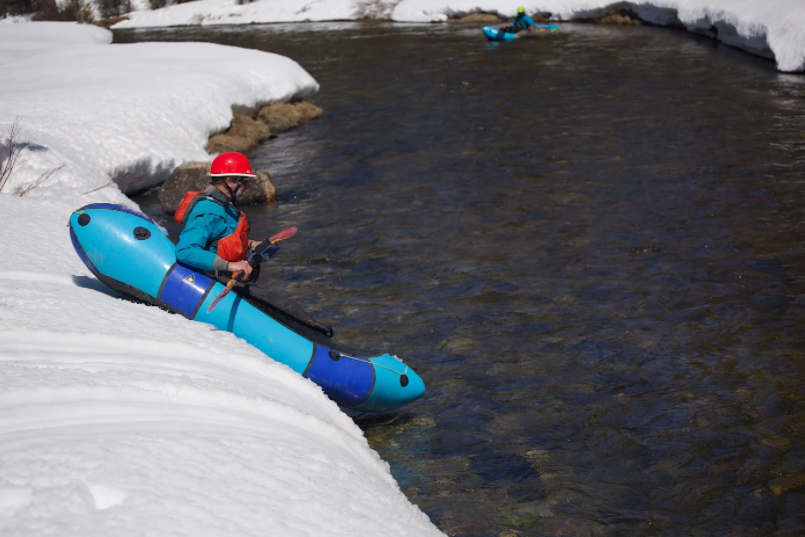
The early miles were slow, with lots of bumping and grinding across barely covered cobbles and hasty avoidance of wood problems. The shot below is the first riverwide snow bridge, which was followed by ~a mile of successive wood portages. It was hot, sweaty work postholing our laden boats, with teamwork often required to find routes through or to get inflated boats over and under woodpiles without damage.

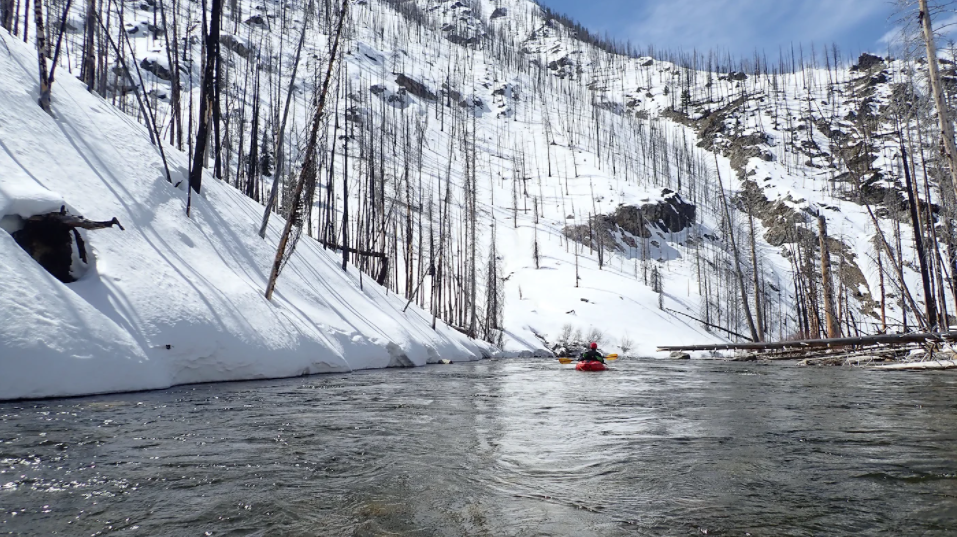

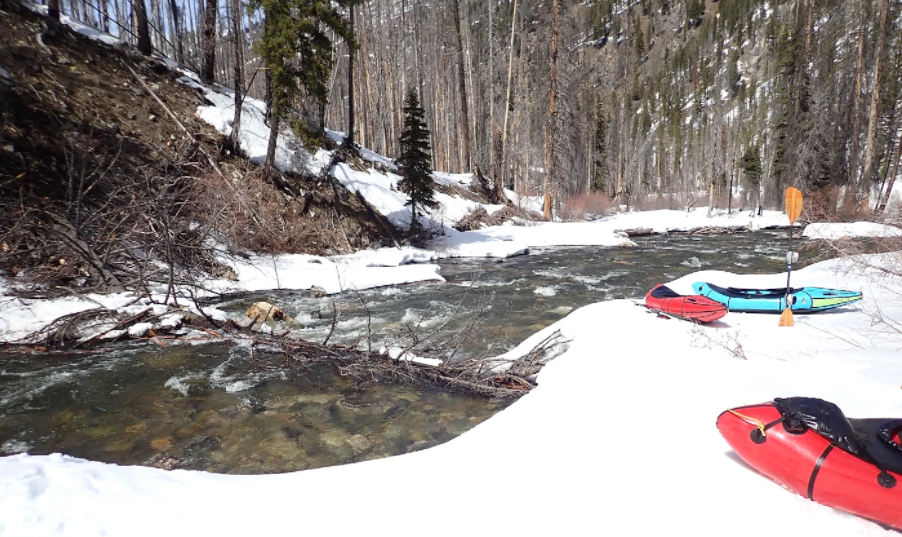
Late in the afternoon, just below the confluence with Bear Valley Creek -- where the flow roughly doubled and we could finally take vertical paddle strokes -- we sussed out a campsite. Said Tom: "There are something like 100 camps along the Middle Fork of the Salmon below the Boundary Creek put in, but upstream there are few. And in mid-April there aren’t many that are snow-free. We found a small camp that had just barely melted out. I like snow as much as anyone, but after 5 days of camping in the snow it was nice to find a small island of dry, warmish (!!) dirt in the middle of an endless blanket of white on the banks of the river for our first proper river camp."
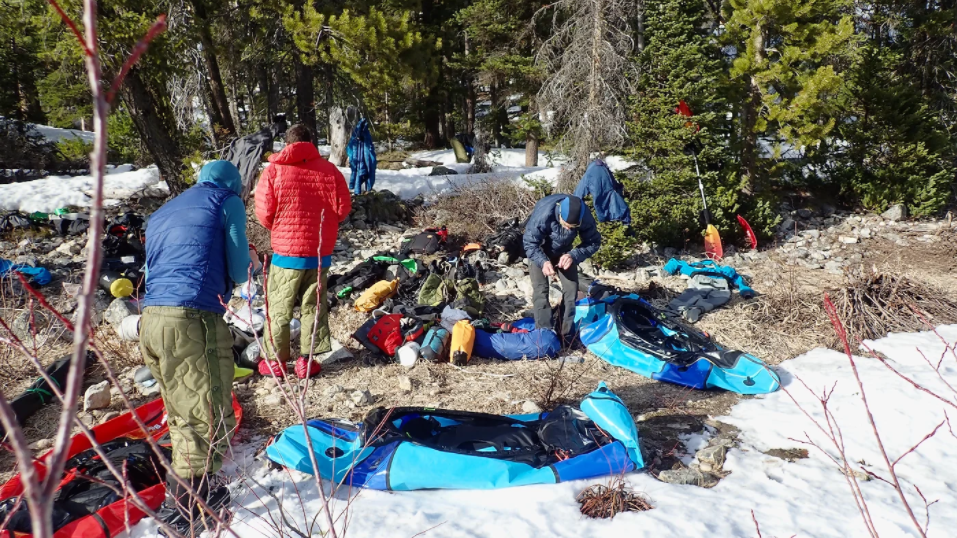
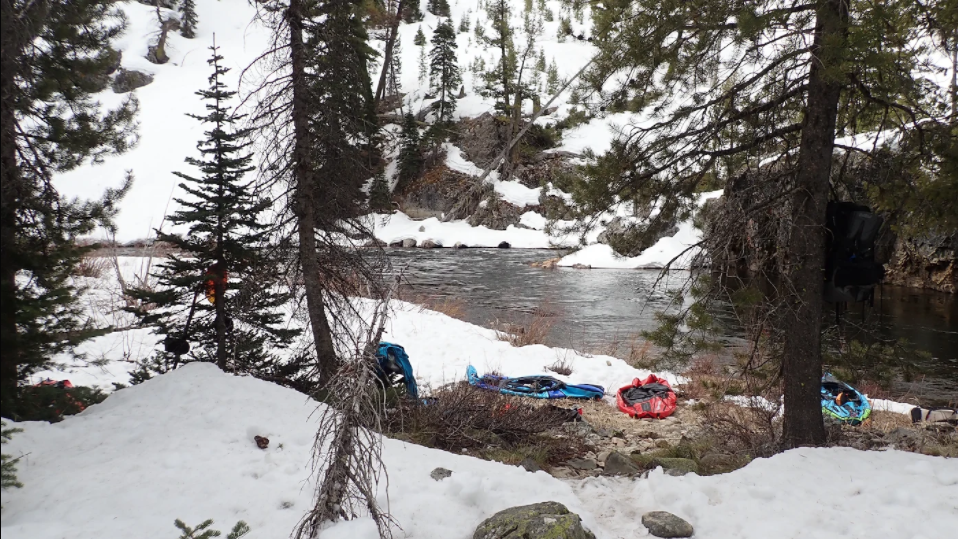
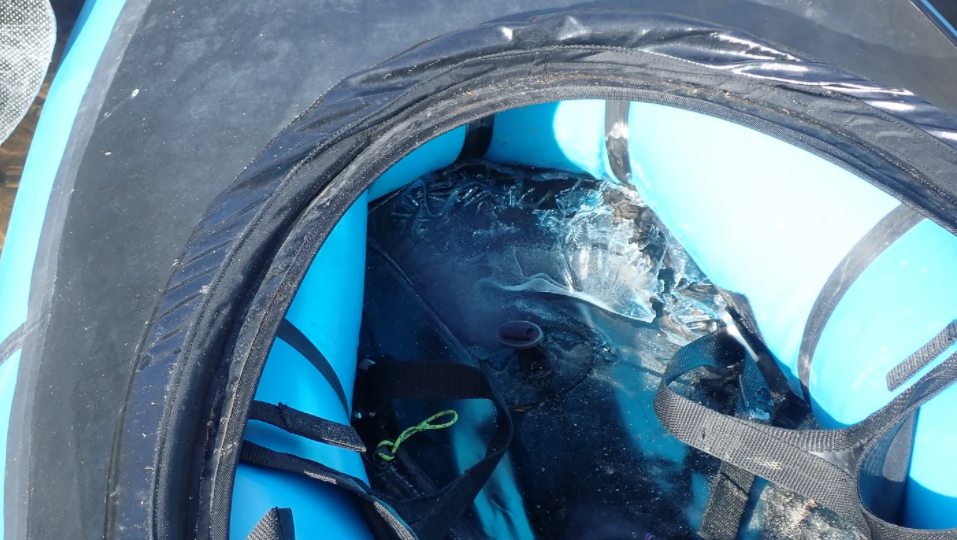
Temps were still well below freezing at night, necessitating that we take care in how we hung our drysuits before bed, as well as mandating that we dunk shoes in the river for a spell to thaw them enough to wedge feet in the next morning.
The most important thing that I want to share about this leg of our traverse has nothing to do with temperatures, river flows, rapids, or snowpack.
Food is what we seemed most focused on. We'd just skied ~60 miles through the Sawtooths with our homes on our backs, after all. Because we'd picked up a cache before launching, and because the USFS requires a firepan, we planned to cook on, over, and in fire. Bacon and brats. Biscuits and goat cheese. Chorizo. Fresh cookies. Cheesy tots, cheesy hash browns, grilled cheese on rosemary bread. And/or rye. Endless acres of soups.
Bryan won the bougie food award while Jeff and Jesse seemed hell bent on consuming their body weight in food every night. Repeatedly I thought they'd outdone themselves in sheer quantity only to find they were merely finishing the first course. Meals lasted for literal hours. I didn't know it was possible to get tired from eating.
When I asked Jeff to share his favorite memory from this part of our journey he replied without hesitating: "Starting down Marsh knowing I had an obscene amount of real food to share with Jesse, then developing a (justified) fear of eventual food shortage as I spent hours cooking and eating fried everything with cheese, sausage and cookies at camp, as Jesse matched me pound for pound."
When finally we managed to squeeze overstuffed bodies into drysuits and boats the next morning, the Middle Fork was engaging and fun and -- with snow and ice covering the ubiquitous wood piles -- oddly pretty.
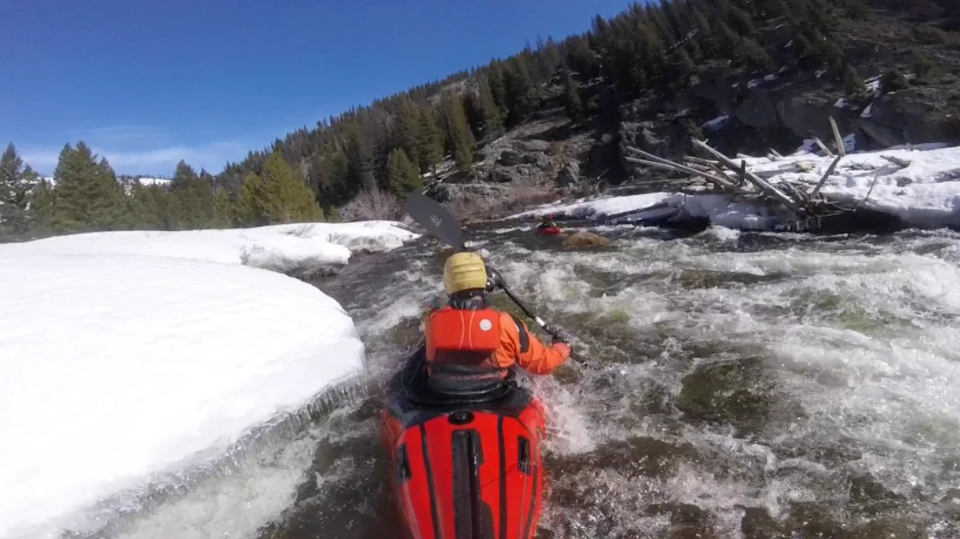
Although the snow was fading fast the temps weren't budging. These two pics were taken at a 1PM lunch break. Said Jeff: "I adjusted my PFD shoulder straps and nose plugs because they were pulling at my face -- then I realized instead it was flash frozen spray tugging on my beard as I paddled."
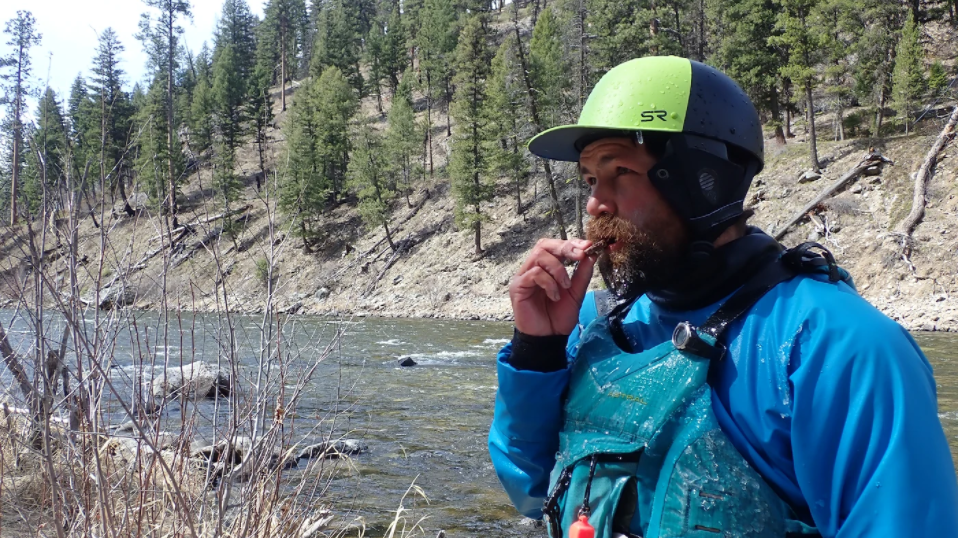
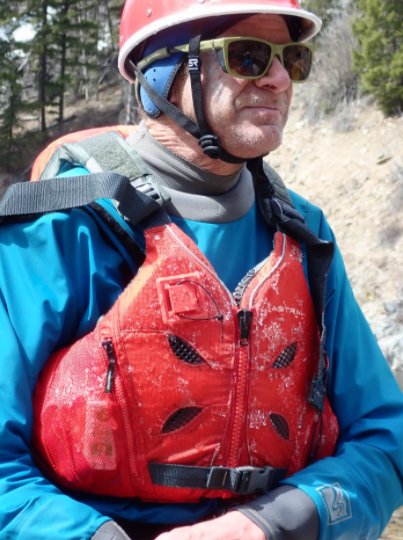
To date I've not yet run Dagger Falls. I had some hopes that this would be the trip. Alas we arrived and found it janky, junky, with some wood in play, and no one had any interest. The ~20 minute portage helped to move some ballast deeper into our bowels -- making a sliver of room for the evening feast fast approaching. That aside, what was most memorable about the upper Middle Fork was each side stream that contributed to the flow, padding things out and opening up funner lines as we descended.
Downtime in camp, wildlife sightings, hot spring frozen-foot-soak intermissions, increasing amounts of color in the flora, snack breaks, and learning/remembering how to pilot and surf our boats were the highlights of every day. Bryan and Tom were in Alpacka Wolverines, Jeff, Jesse and I had 3 different iterations of Alpacka's new Valkyrie. Sporty boats, all.
On the third day my boat had a persistent leak that required me to continually stop to reinflate it, earning me that guy status. At camp that night I climbed all over it, while still in the river, looking for leaks. It resolved itself to be a wad of my cat's fur lodged at/into the base of the Cargo Fly. Once removed there were no leaks the rest of the trip.
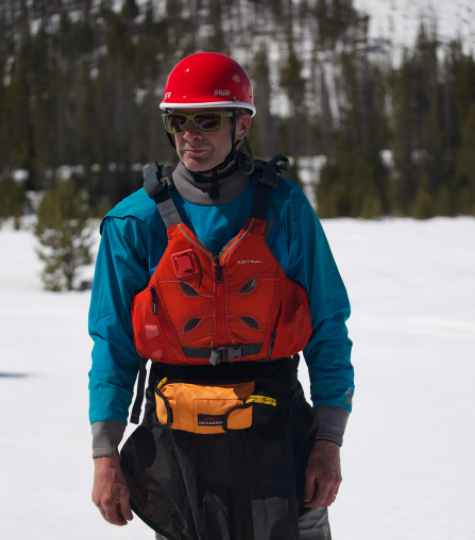
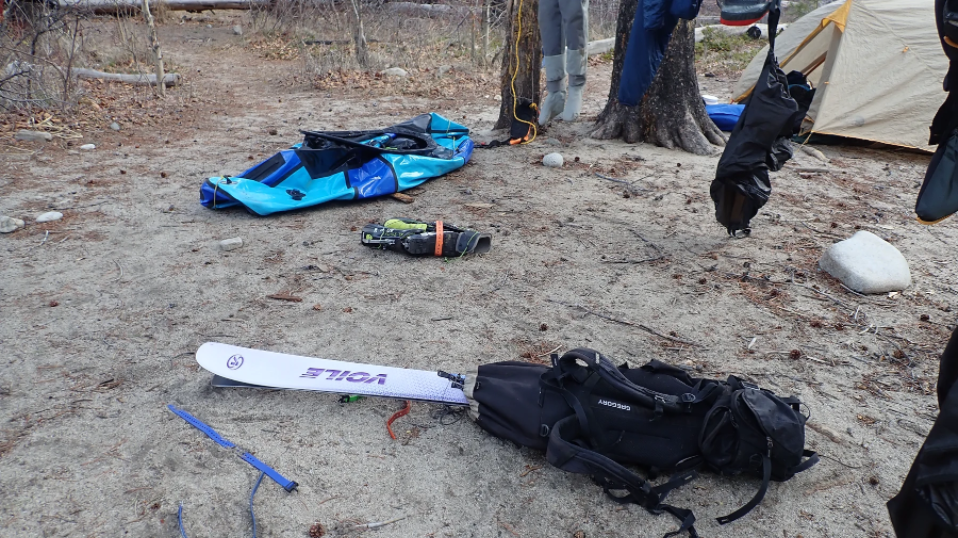

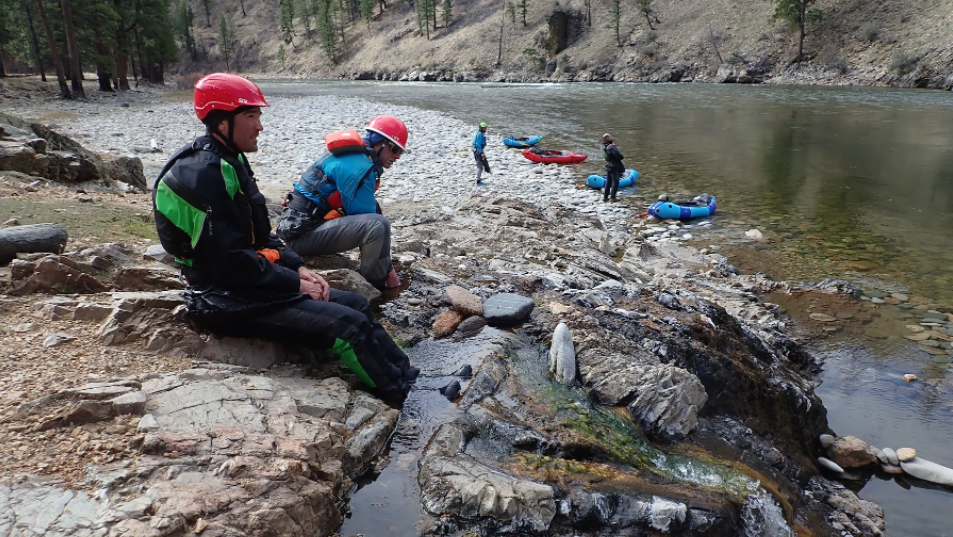
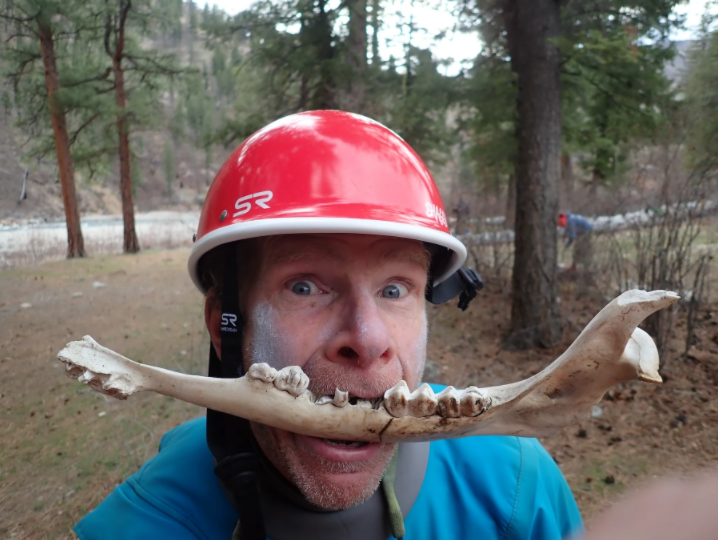
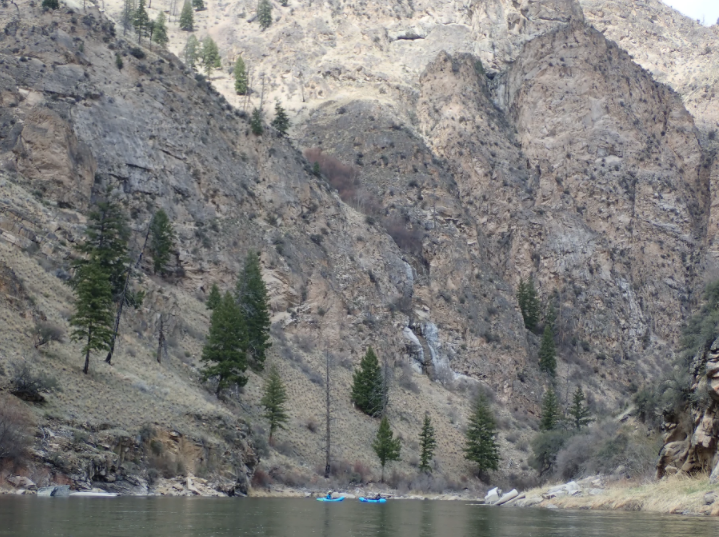
On one section of the Middle Fork we saw an enormous golden eagle. And then another. And then two balds. And then another golden. All in ~one mile. While drifting along, necks craned to marvel at them, Jeff cleared his throat to break the silence, declaring in his most Dude-like voice, “I hate the fuckin’ eagles, man...”.
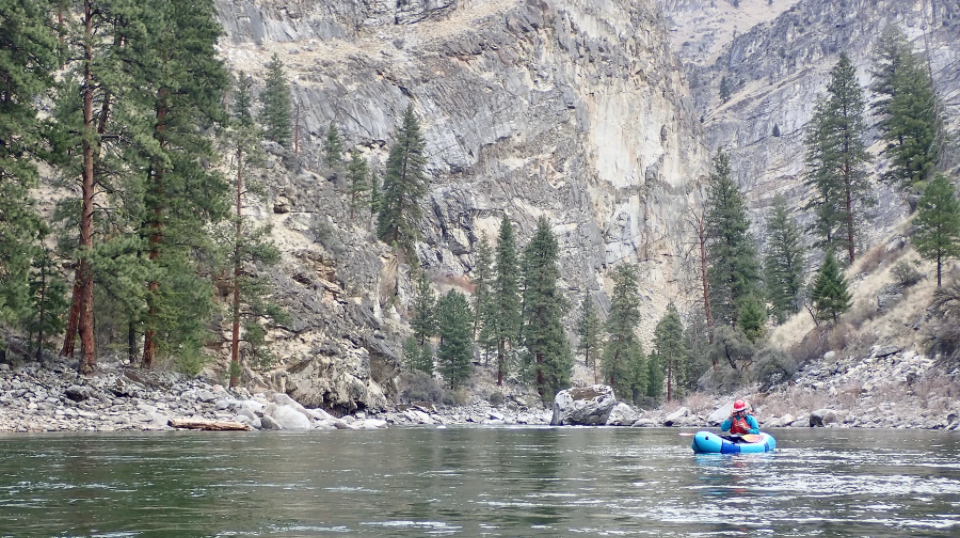
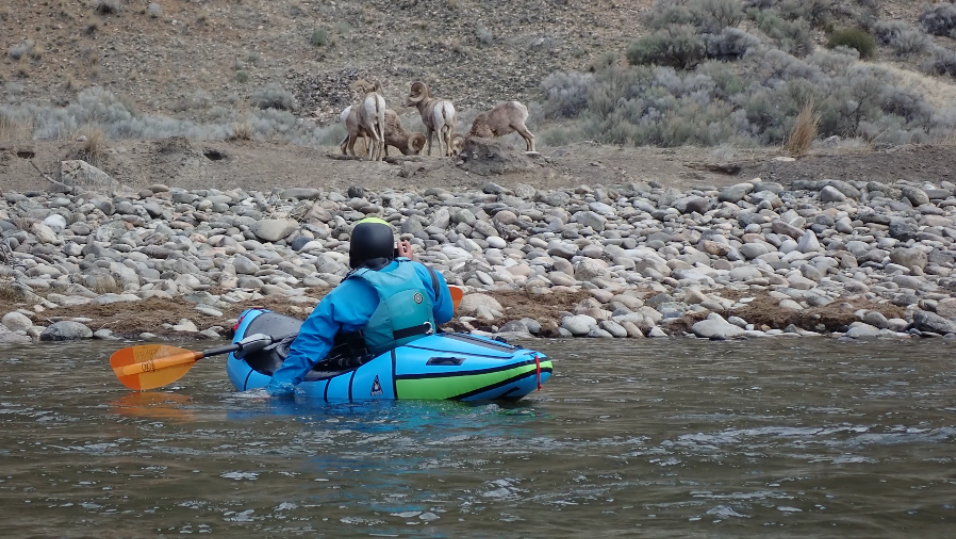
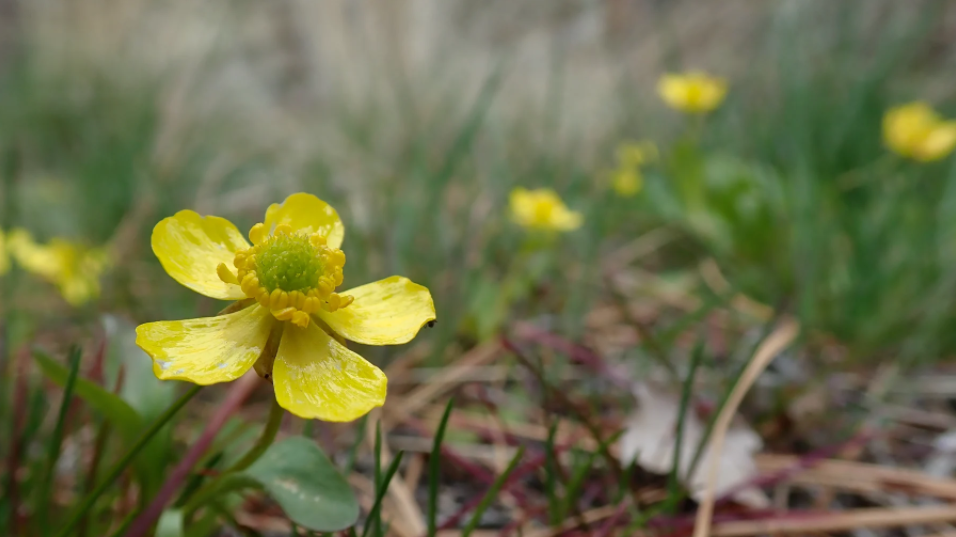
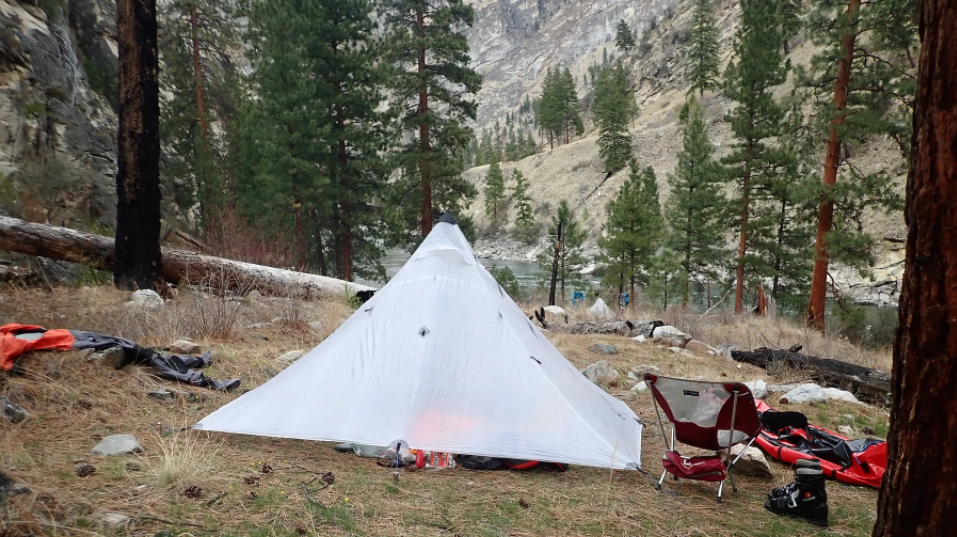
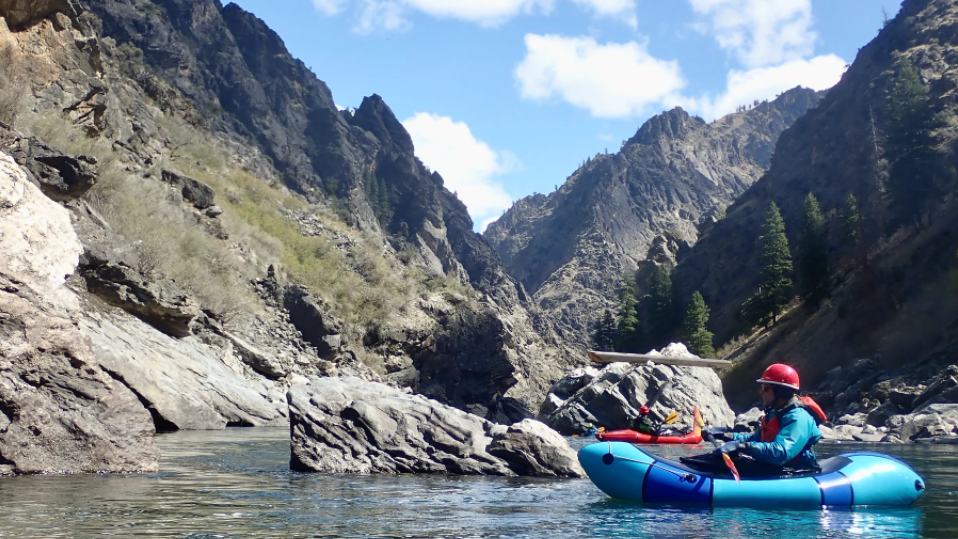
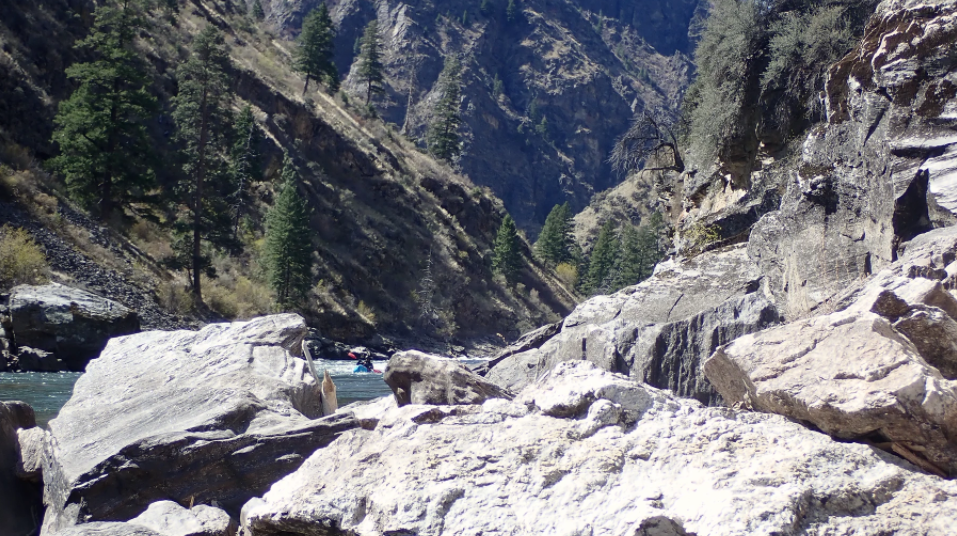
The scenery in the Impassable Canyon is always worth that which precedes it. Some of the rapids, too.
At Cache Bar we stashed our firepan and various other non-necessary sundries for later retrieval, then floated another few hours down the Main. A sun-soaked grassy flat spot greeted us at Horse Creek, where we disgorged contents of boats, dried gear, reassembled ski kits, and generally readied ourselves for some hard effort after 5 easy days oozing down the MF.
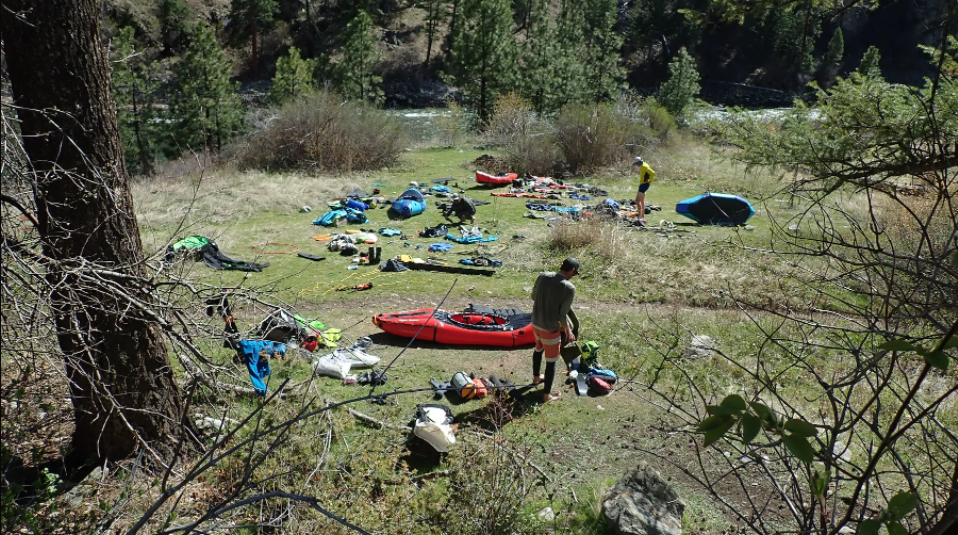
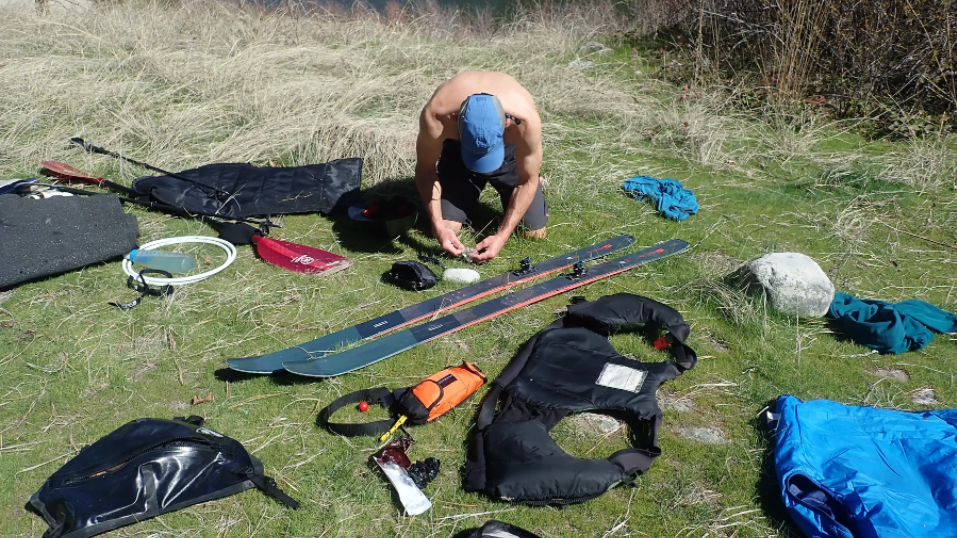
Leaving the Main our packs were laden with full whitewater boating kits, backcountry ski kits, late winter camping kits, plus 5+ days of food. I'm sure I've hoisted a heavier pack, but I really can't remember when. And when it came time to move I needed Bryan's help to get it onto my back.
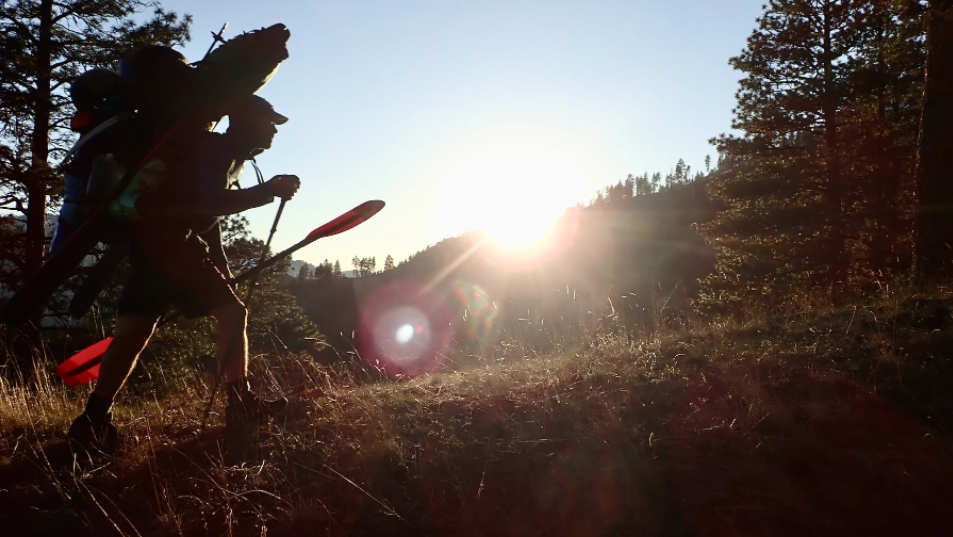
A few miles and a few thousand vert disappeared under our feet surprisingly quickly. Afternoon temps were warm but we were saved by a western ridge that blocked us from direct sunlight. We made camp on the shoulder of a ridge with a stunning view out over the canyon of the Salmon. Alas, reverting to freeze dried food inspired no one.
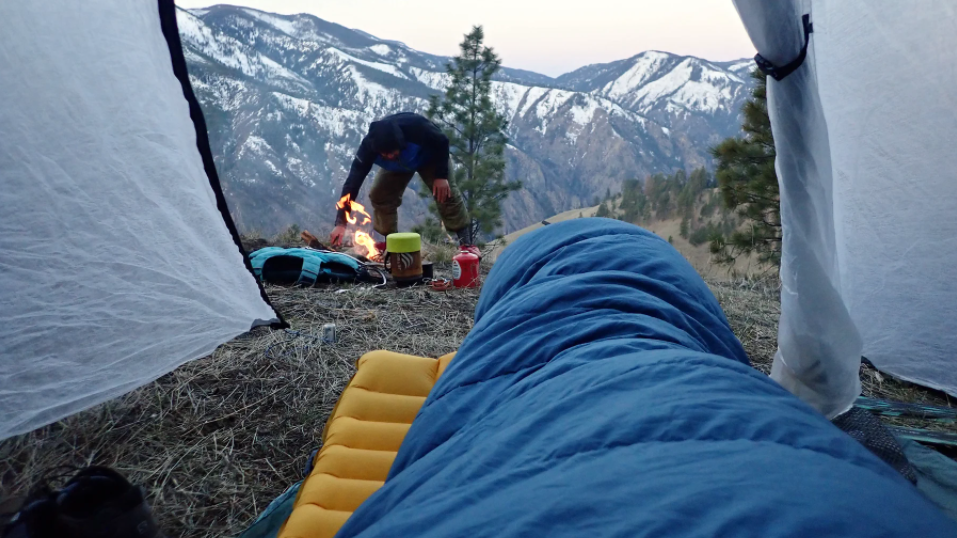
Cone-littered duff trail beckoned us up out of camp in the morning. No more than an hour after starting we hit the first substantial patches of snow, and after an easy ~30 minutes of mixed snow/dirt walking we were able to transition to sliding. The relief of getting skis and boots off our backs was palpable, but our laden packs still tempered any enthusiasm for moving at other than a plodding pace.
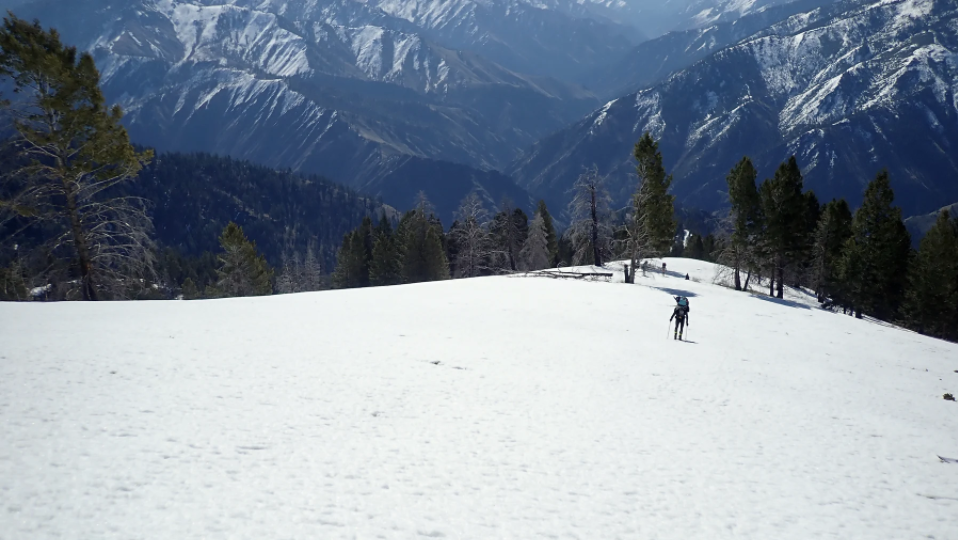
As we ascended the never-ending flank of the plateau we took occasional snack and pack-off-back breaks wherever shade could be found. If I sensed that the group was settling in for more than a moment I'd doctor my crumbling heels with more layers of leukotape, then grab a pic or two before it was back to the grind.
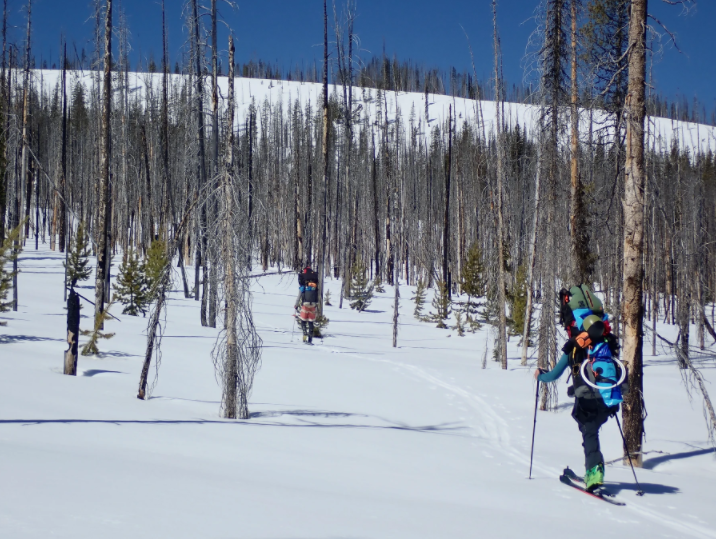
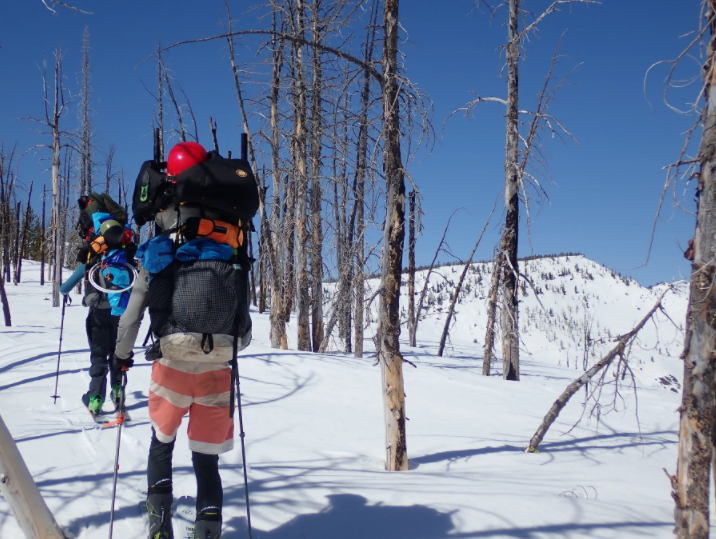
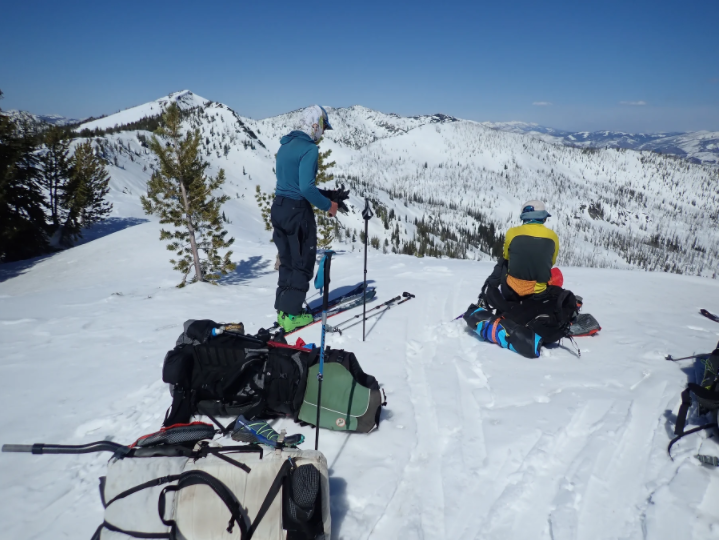
At one of these breaks Jeff asked a confounding question. It came across as such because Jeff isn't one to make smalltalk -- when rarely he speaks it's usually because he has something of substance to contribute.
Jeff: "How's your pack feel?"
Me: "Um... uh...
...terrible?"
...pregnant pause...
Me: "What answer were you looking for?"
Jeff: {silence}
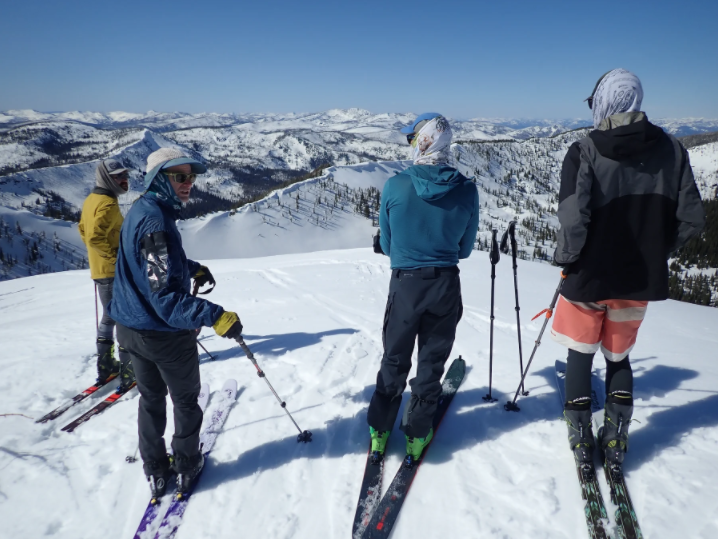
We dropped packs and made a slight detour to the summit of 8887' Waugh Mountain, taking in 360* views of the Bitterroots, Gospel Hump, Pioneers, Bighorn Crags, and the bulk of central Idaho and western Montana. And then we arced delicious 25mph soft-corn turns back down to retrieve our burdens.

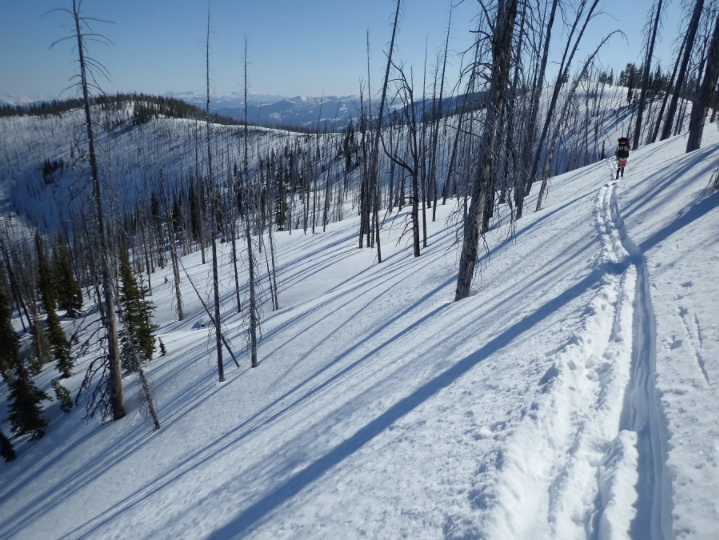
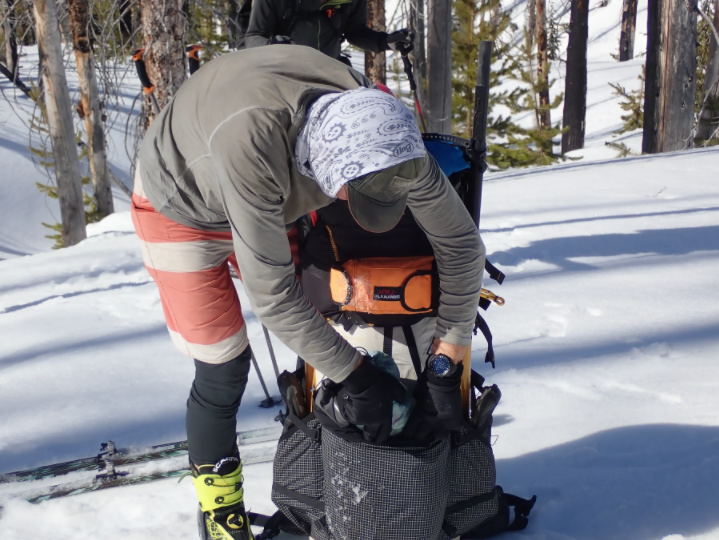
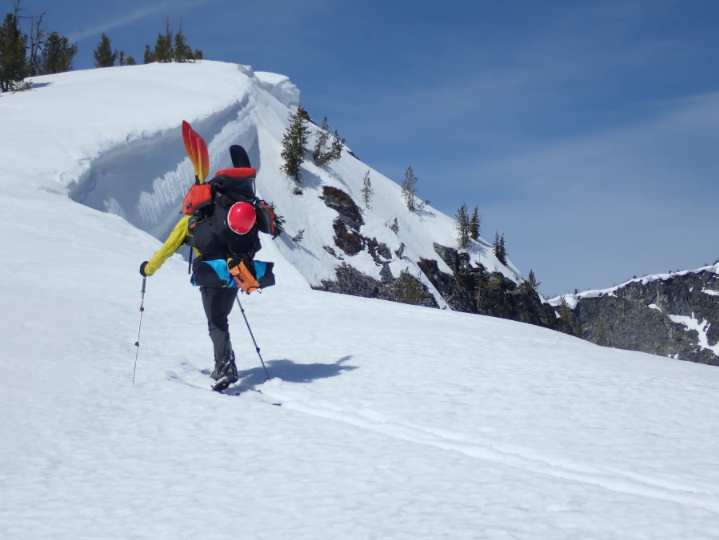
With high pressure, mild temps, and light winds the snowpack didn't evolve much on our three day traverse between the big rivers. Southerly aspects were frozen stiff in the mornings, northerlies were reliably funky regardless of time of day. Wind crusts, sun crusts, and sun-baked wind crusts dominated. On SE or SW aspects you could expect to be surprised by the variety of the funk. Travel across these surfaces was reliably fast if not particularly fun.
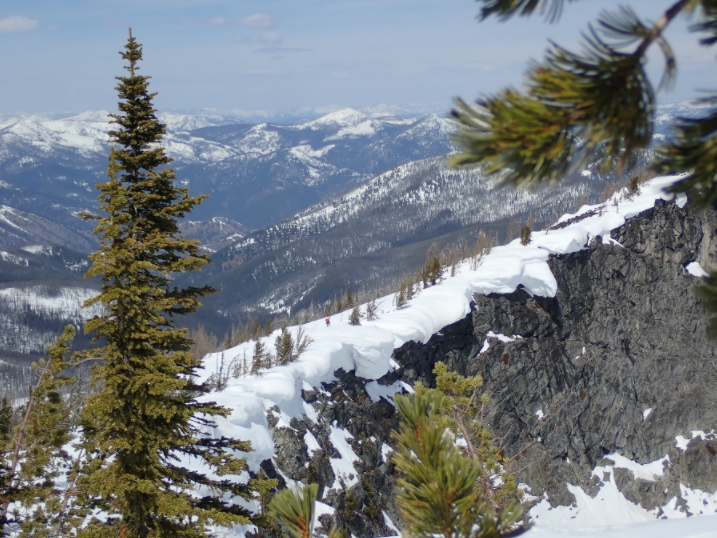
As we neared the Selway the frequency with which we overlapped fresh wolf tracks increased substantially. High on the ridgelines we crossed many sets that were a few hours to maybe an hour old. Down in the valleys they must have felt more comfortable veering in to check us out, for some tracks couldn't have been laid more than mere moments before.
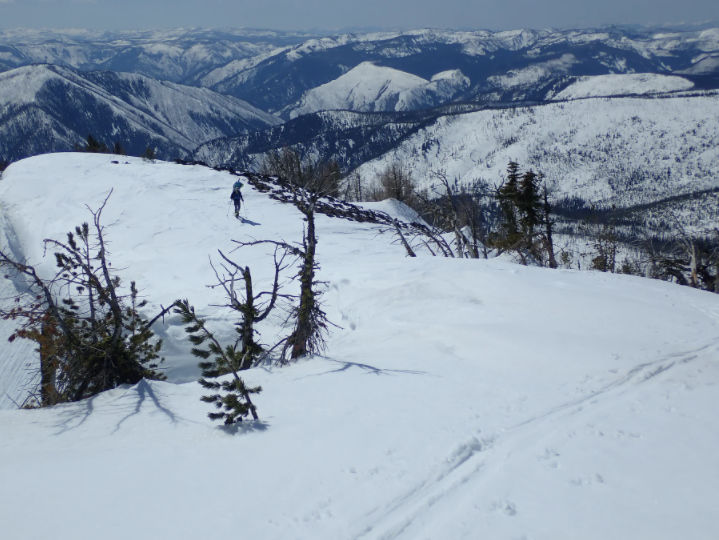
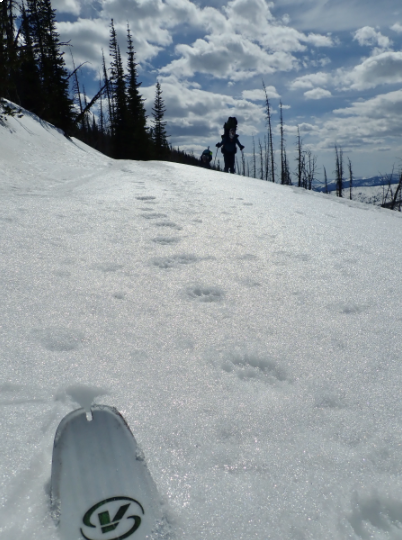
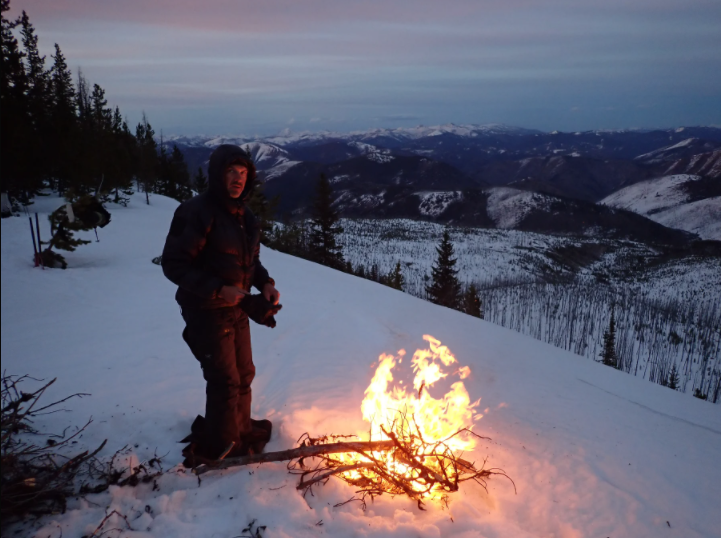
Jeff gave a meandering lecture on weather in this part of the Rockies as we set up bivies for our last night up high. I didn't follow every twist and turn -- I'm not sure anyone did -- but the gist seemed to be: Given where we are and what the clouds are doing, it's not going to precipitate any time soon. I'm sleeping out.
I was tempted to forego erecting my 'mid based on Jeff's confidence in his prediction. But as the fire burned down and people drifted off to their bags the scud grew thicker and it seemed to be getting more humid by the minute. I haphazardly threw up my 'mid and heaved gear inside before passing out.
The snow started around dawnthirty, and made breaking camp a bit less awesome than it could have been.

Our transition from snow back to dirt was complicated by the overnight accumulation. I often had difficulty determining -- while double-poling down the Magruder Road -- where deeper, older snow gave way to fresh atop gravel. I usually found out when my skis ground to a halt on rocks and road base. Gah.
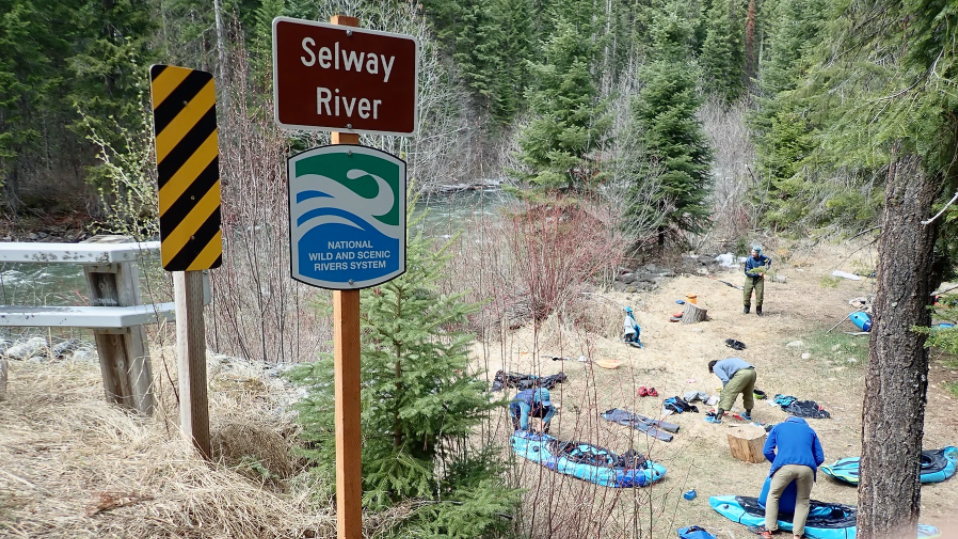
I knew as well as anyone that our trip was far from over, but that didn't stop me from exhaling an Idaho-sized sigh of relief when I dropped my pack on the bank of the Selway. We still had ~80 river miles yet to run, but with the ski and foot legs done it seemed acceptable to revel a bit.
We were also presented with a surprise: Will had skied and hiked ~30 miles in from near Darby, Montana to join us. We all arrived within a few minutes of each other, and set about making our last ski-to-boat transition.
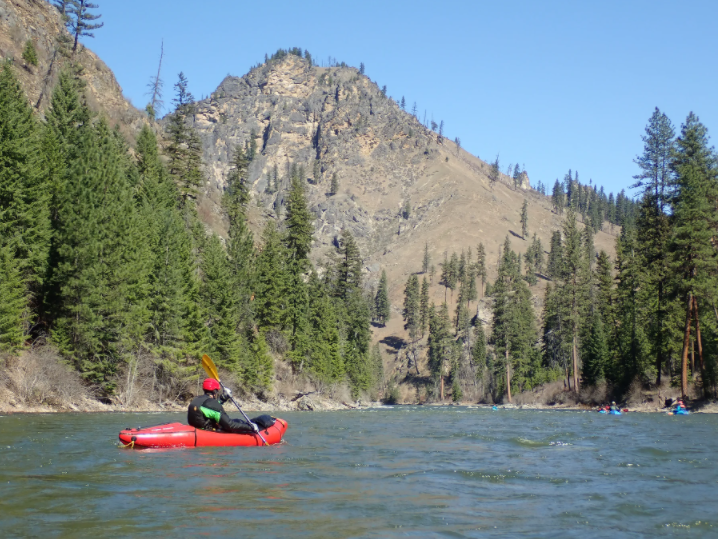
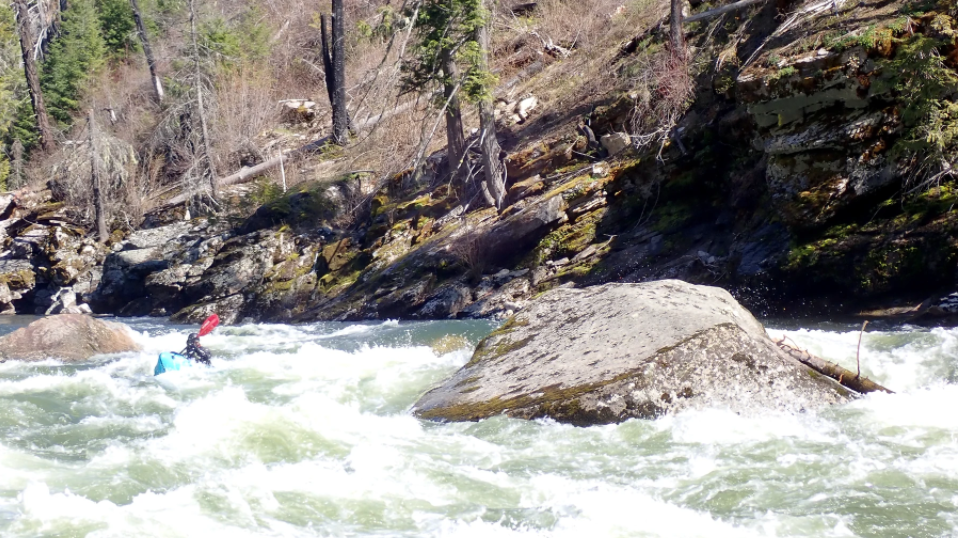
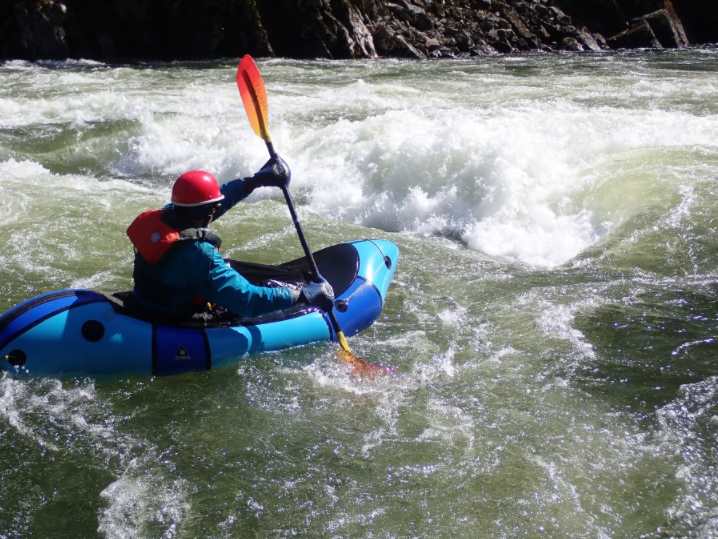

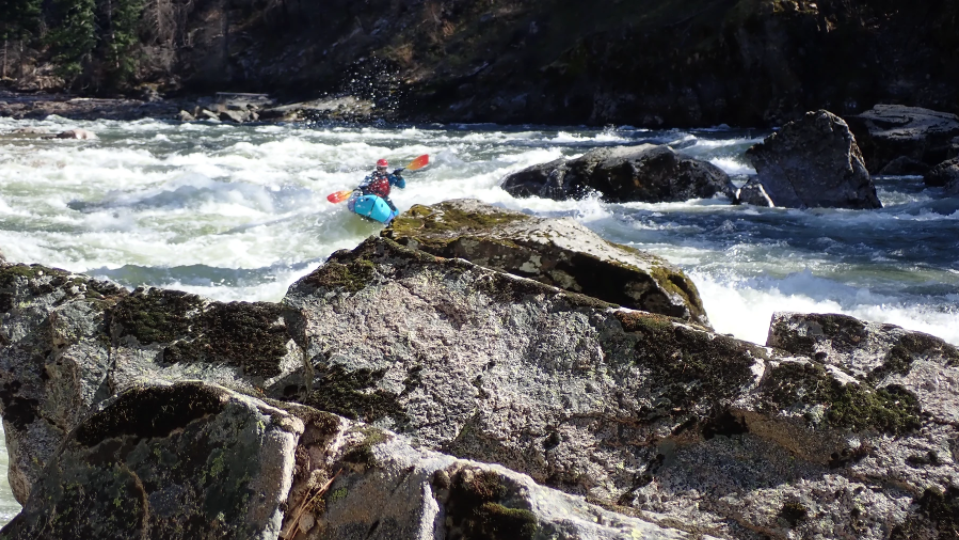
Within ~a mile of launching we dropped in to what felt like a mile-long class IV rapid. Those in the group that had run this high before recalled nothing more than class II boogie until down near Paradise. I mistakenly latched onto that claim and was thusly caught on my heels when the walls closed in and the gradient steepened. I barely caught a mid-rapid eddy then stepped out of my boat to have a look. After the scout the line went clean, but I couldn't quite shake the 'on-my-heels' feeling.
Perhaps sensing this, Jeff asked if I wanted to lead for a bit. My knee-jerk reaction was "Not particularly", but fortunately I checked myself and changed my mind, poking my nose out in front for the next few stunning -- and fun -- mini-gorges. Leading forced me to bootstrap myself back into the game. Thanks Jeff.

The views down this cedar-lined corridor are a bit more muted than those that preceded them. Anyone that's been here before will nod in agreement when they read this next bit: You don't run the Selway for the views.
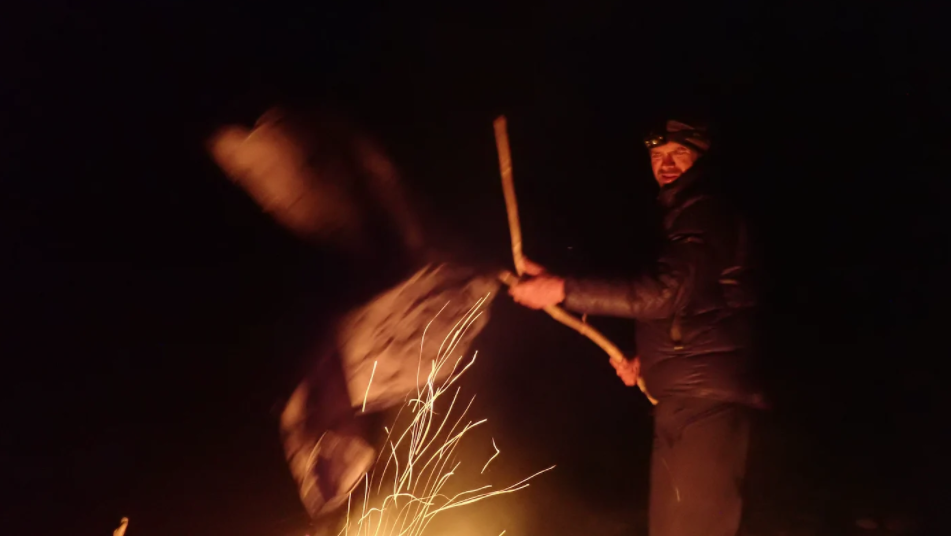
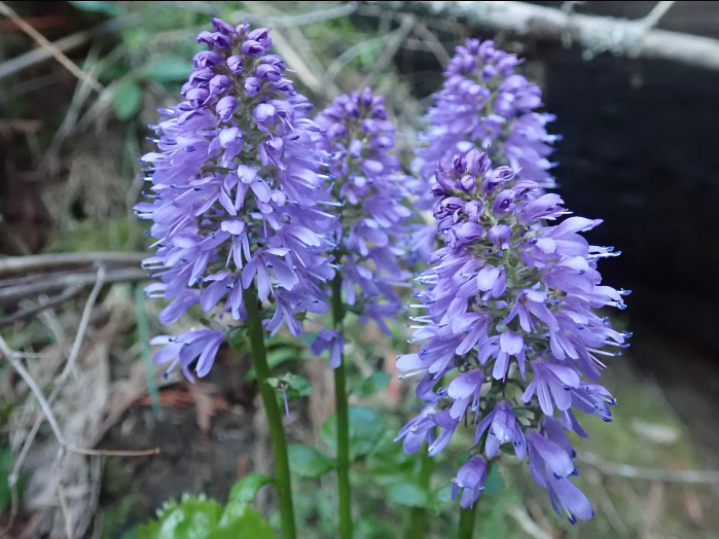
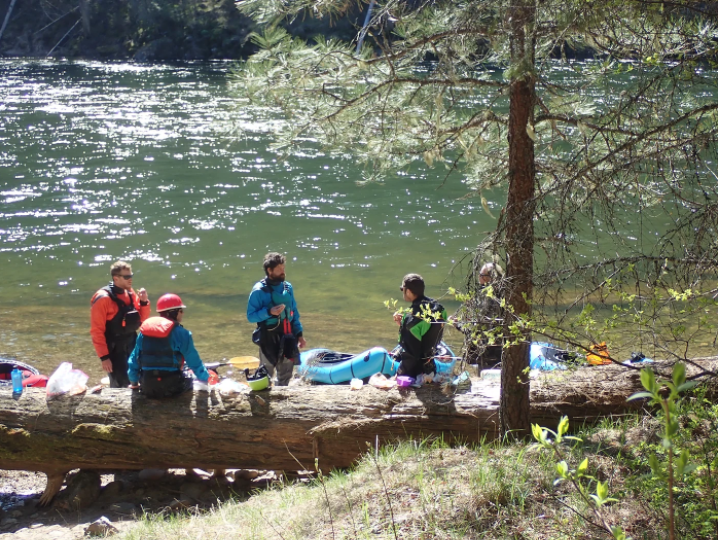
Our last two camps on the river were on blessedly dry ground, albeit crispy with frost each morning. The river stayed right around 7000cfs the whole time we were on it -- sort of a low side of medium flow. Above Moose Creek that flow felt great. I will never not be amazed at the change that happens as the Moose Juice is added: A medium sized stream changes into a pushy, high-volume river in the span of about a hundred meters.

The big named rapids -- Double Drop, Wa-Poots, and Ladle -- all went great after shore scouting. The lesser knowns caused more carnage, probably because the 'big three' were behind us so we let our collective guard down a bit and just routed on through. One of the many beautiful parts about packrafts is that if you fail to roll or otherwise come out of your boat, you just flip it upright and climb back in right then and there. And we did.
We took out just above Lowell, spent all of 20 minutes heaving boats and skis into cars, then went in search of food.
I don't have a flowery way of wrapping this trip report up. 310 miles -- roughly 100 on skis, 5 on feet, and 205 in boats -- over the span of 14 days. It was a lot of effort out, in a relatively short time. I was emphatically ready to get home to eat and sleep and recover.
To complete the route was super, super satisfying. One of the most satisfying parts is that we didn't need to fly to Alaska to see so much wild country.
A month after the fact I still feel a bit run down, and am using some of the needed downtime to research future skiraft missions. How many places in the Lower 48 can you cover 300 miles and only cross two roads?!


Comments